In 1964 Moueix finally realized his dream and purchased a 50% interest in a vineyard he’d long coveted. By 2000, he was the outright owner. The vineyard was called Pétrus. Moueix believed it was producing as great a wine as any of the first growths in Bordeaux. In spite of Moueix’s enthusiasm, Pétrus was not yet well-known in established wine circles. That would soon change.
Throughout the 1950s and 1960s Moueix was a tireless crusader (some would say an inexhaustible promoter) for the wines of Pomerol. His spectacular rise to a leadership position and accumulation of enormous wealth was, in short, accomplished by working extremely hard and producing exceptional wines, particularly at his two flagship châteaux, Pétrus and Trotanoy. In the 1960s and early 1970s, these two wines often surpassed the first growths of the Médoc.
The extraordinary rise to prominence of both Moueix and his wines brought Pomerol attention and prestige that did not go unnoticed by other producers in this bucolic appellation. As a result, other properties began to upgrade the quality of their wines. Today, while no one can challenge the domination that Jean-Pierre Moueix’s firm enjoys over the sale of the wines of Pomerol, there is an increasing number of challengers to the previously uncontested superiority of Pétrus, particularly wines such as Lafleur, L’Evangile, L’Eglise-Clinet, Vieux Château Certan, Le Pin, Clos l’Église, La Fleur de Gay, and sometimes La Conseillante as well as Clinet.
The most celebrated Pomerol châteaux are located on the plateau of Pomerol. Pétrus sits on the highest elevation, and most of its acreage benefits from a soil base that is largely clay; the surrounding prestigious neighbors have much more gravel. Within shouting distance of Pétrus are La Fleur Pétrus, Certan de May, Vieux Château Certan, Le Pin, La Conseillante, Gazin, Hosanna, and L’Evangile. Immediately to the northwest are Lafleur, L’Eglise-Clinet, and La Fleur de Gay. Yet while these vineyards’ deep, gravelly soils (which also contain some clay) are excellent for both the Merlot and Cabernet Franc grapes, only Pétrus is planted with 95% Merlot and 5% Cabernet Franc. Other Pomerol properties, recognizing the fact that Cabernet grape varieties, especially Cabernet Franc, are well suited for this soil, plant somewhat higher percentages of Cabernet Franc.
Heading west, toward the end of the plateau of Pomerol, where Trotanoy is located, the soils become even more gravelly. Properties in this locale often excel in wet vintages because of the superb drainage provided by these deep beds. Farther west, in the direction of Route National 89 (connecting Libourne and Bordeaux), the soil changes to a mixture of gravel and sand, then to a light sandy, flint-based soil. These areas cannot support the production of long-lived wine, but many soft, fruity, extremely pleasant and supple Pomerols are made in this sector. However, even the best of these wines will never have the strength, aging potential, or richness of the Pomerols from the gravel and gravel/clay/iron-based soils of the plateau.
For those familiar with the Médoc and Graves regions of Bordeaux, Pomerol—with its limited acreage and modest farmhouse “châteaux”—must come as a surprise. Pétrus itself is a remarkably humble building that truly stretches the definition of “château” to the limit. The appellation’s largest estate, de Sales, is the only Pomerol property to have a building that could be said to resemble a Médoc château—and a modest one at that. The other three sizable vineyards of Pomerol are Nenin, Taillefer, and La Pointe. Not one of these three estates, however, could be accused of being in the top-league of quality, although Nenin’s purchase by the late Michel Delon (of Léoville Las Cases) in 1997 was cause for excitement for Pomerol enthusiasts. Most of the best Pomerol vineyards encompass between 20 and 34 acres, but many are much smaller. For example, three current Pomerol superstars are true micro-estates. Lafleur, Clos l’Église, or L’Eglise-Clinet could sell their entire production within the Bordeaux city limits if they desired. None of these estates is larger than 15 acres.
What are the telltale characteristic traits of Pomerol wines? The dense ruby color, the intense berry fruit, plummy, sometimes truffle, mocha, and caramel-scented, ripe, fruity, often black cherry and raspberry-dominated bouquet, and a lush, voluptuous, almost unctuous texture—at least in the top vintages—are all hallmarks of a top Pomerol. Welcome to the glories of the Merlot grape.
As for the styles of wine produced in Pomerol, generally these are Bordeaux’s most gentle, smooth, silky, lush, and richly fruity wines. However, that does not explain the diversity of styles that can be found; the individual producers do. At the top end, the overall quality of winemaking in Pomerol is extremely high, but once past the obvious stars, quality slips badly.
Pétrus is frequently claimed to be this appellation’s greatest wine. Massively concentrated, rich, and long-lived in the 1940s, 1950s, 1960s, and early 1970s, Pétrus had few rivals for its concentrated, almost vintage Port-like style that characterized such legendary vintages as 1975, 1971, 1970, 1964, 1961, 1950, 1949, 1947, and 1945. Yet manager Christian Moueix (his brother, Jean-François, a significant négociant in Bordeaux, is the actual owner) and his ultraconservative oenologist, Jean-Claude Berrouet, began in the late 1970s to move Pétrus toward a more disciplined, polite, and elegant (some said Médocain) style. This new style of Pétrus rarely had the weight, unctuosity, and depth of the vintages that made this property famous. To my palate, only the 2000, 1998, 1990, and 1989 resemble, in a more elegant style, the marvels of the past. But lest anyone forget, the heavy clay soil that the vineyard of Pétrus still sits on results in a powerful, very tannic wine. Yet until the early 1980s Trotanoy was often indistinguishable from Pétrus in blind tastings and was clearly the most complete and demanded Pomerol (along with Lafleur) after Pétrus. Not surprisingly, Pétrus is made from 95% Merlot and Trotanoy 90%, and they are treated identically by the same Berrouet-led winemaking team.
Before 1976, the other Pomerol that had always rivaled, and in many vintages eclipsed, Pétrus, but is terribly obscure, is the tiny estate of Lafleur. Interestingly, Lafleur’s vineyard sits adjacent to that of Pétrus on the plateau, and it, too, has extremely old vines that render small quantities of very concentrated, exotically flavored, highly structured grape juice, but Cabernet Franc gives Lafleur a totally different character than Pétrus.
If Pétrus, Trotanoy, and Lafleur have traditionally made Pomerol’s richest, deepest colored, most massive wines, L’Evangile, La Conseillante, Petit Village, La Fleur-Pétrus, and L’Eglise-Clinet produce this appellation’s most graceful, smooth, elegant, Burgundian-like wine. Prior to 1976, none of these properties could lay claim to making as massive or as rich a wine as Pétrus, Trotanoy, or Lafleur, but today Pomerol enthusiasts are likely to find some of these wines bigger and more concentrated than Pétrus, particularly L’Eglise-Clinet, L’Evangile, and in 1989 and 1990, Clinet.
L’Evangile and La Conseillante justifiably have two of Pomerol’s finest reputations but have been irregular performers. La Conseillante was a notorious underachiever during much of the 1960s and 1970s but came on strong in the 1980s, making some of the greatest wines in its famed history. The 2000, 1998, 1990, 1989, 1985, 1983, 1982, and 1981 are decadently hedonistic beauties. L’Evangile has also been inconsistent. But when it makes superb wines, they rival the best of the appellation. L’Evangile made spectacular wines in 2000, 1998, 1995, 1990, 1985, 1982, 1975, 1961, 1950, and 1947. Given the fact that L’Evangile was acquired by the Rothschild family (of Lafite Rothschild), this property finally has the financial resources to challenge Pétrus, both in quality and price; the sumptuous 1995 and dreamy 1990 were starting points. Both the 2000 and 1998 should provide persuasive evidence that L’Evangile is worthy of Pétrus and Lafleur.
La Fleur-Pétrus has the right name for fame, yet it rarely seems to produce wines at a level its name suggests it could. With the acquisition of a parcel of old vines from Le Gay in the mid-1990s, this has changed. Historically, it is a very good rather than superb Pomerol, velvety, quick to mature, yet elegant and graceful. The 2000 and 1998 are glory bound.
Petit Village lacked the meticulous care and concern that comes from a committed proprietor. This potentially great vineyard began to make top-flight wines in the late 1970s under the guidance of Bruno Prats. Prats then sold the property, and Petit-Village improved in quality, with superb vintages in 1990, 1988, 1985, and 1982. More recently the wine has been very good but less consistent than I would have expected. At the time of writing, a proposed sale of this estate to St.-Emilion’s wunderkind, Gerard Perse, was suspended indefinitely.
Since the release of their great 1985, L’Eglise-Clinet has been a rising superstar of the appellation. Historically, L’Eglise-Clinet has had plenty to boast about. The 1959, 1957, 1950, 1949, 1948, 1947, 1945, 1929, and 1921 are amazingly rich wines that have stood the test of time. Yet an undistinguished period in the 1960s and 1970s caused many to forget this splendid estate. Possessed with some of Pomerol’s oldest vines, this traditionally run property produces an explosively fruity, densely colored Pomerol that always seems to taste like the essence of black fruits and minerals. Significantly, it is one of the few tiny Pomerol estates to employ a second wine for vats considered not rich enough for the grand vin.
One style of Pomerol might be compared to the “Médoc” wines. Two Pomerol estates, Vieux Château Certan and Clos l’Église, do indeed make wine with a high percentage of Cabernet Sauvignon and Cabernet Franc (rather than Merlot), and their wines often have more Médoc-like characteristics than other Pomerols. Vieux Château Certan has the greater reputation of the two, and in the 19th century and first half of the 20th century it was considered among the greatest Pomerols. The 1950, 1948, and 1947 are legendary. However, this property’s wines passed through an uninspired period in the 1960s and 1970s that resulted in a decline in their reputation. That has been reversed since the 1982 vintage. The 2000, 1998, and 1990 are profound wines. Clos l’Église, a major disappointment under the management of Christian Moueix and his overly cautious oenologist, Jean-Claude Berrouet, was sold in 1997 to the Garcin-Cathiard family. In just one vintage, 1998, the new proprietors, backed by Bordeaux’s most talented oenologist and taster, Michel Rolland, took a moribund estate and produced a compelling wine. That success was followed by additional triumphs in 2001, 2000, and 1999, making the failures of the Moueix era even more difficult to comprehend.
Another school of Pomerols produces wines that are light and supple and that offer immediate drinking. These wines rarely last more than a decade, but they do provide considerable value in an appellation whose wines are fetching higher and higher prices. Most of these Pomerols are located in the western part of the area on light, sandy soils. None of them has great a reputation, but several of these estates, particularly L’Enclos, Clos René, and de Sales, make complete wines that satisfy the palate, the purse, and the impatient.
There are numerous other Pomerols, and perhaps the greatest story of the 1980s was the emergence of such estates as Certan de May, Clinet, La Fleur de Gay, and Le Pin.
La Fleur de Gay was inaugurated in the 1982 vintage by Dr. Alain Raynaud, the proprietor of the well-known Pomerol château La Croix de Gay. It is very unusual in Bordeaux to see a proprietor take a parcel of his very best vines (in this case a plot of 100% Merlot located near Pétrus and Lafleur) and make a separate wine from it. La Fleur de Gay, aged in 100% new oak casks, is a wine of astonishing richness and exotic superripeness. One sip of the 2000, 1998, 1990, 1989, or 1988 will make anyone a believer. Ironically, the debut vintage, 1982, was a disappointment.
Clinet was another perennial underachiever until 1985, when the son-in-law of the proprietor, the late Jean-Michel Arcaute, assumed management of the property. In a remarkably short time, Clinet shed a cloak of mediocrity and started to produce wines that are among the most complex and profoundly concentrated of the appellation. This quickly became one of the titans of Pomerol, capable of challenging the very best. For example, virtually perfect expressions of wine were produced in 1990 and 1989. After Arcaute drowned in a tragic boat accident, Clinet was sold. The new proprietor is, however, serious about quality.
The other superstar to emerge during the decade of the 1980s is the micro-estate of Le Pin. This wine, made from a tiny vineyard that is nearly 100% Merlot, is perhaps the most extraordinarily perfumed, hedonistic, kinky wine in Bordeaux. The proprietor, Jacques Thienpont, decided to make a wine in the image of Pétrus but even more exotic. The only question concerning Le Pin is how well it will age. Undeniably, it has become a cult wine for international billionaires willing to pay the astronomical prices this wine fetches at auction, and it is often cited as the catalyst for the “garage wine” movement in neighboring St.-Emilion. Moreover, the wine has aged better than its critics have acknowledged. None of the early vintages have fallen apart as predicted by provincial wine writers who seemingly live only to protect the status quo.
Other top-flight Pomerols include Latour à Pomerol, which has made some legendary wines (1961, 1959, 1950, and 1947), but has done little to distinguish itself since; and Le Bon Pasteur, an estate run by two of the world’s most gifted oenologists, the husband and wife team of Dany and Michel Rolland. Two properties to watch are Nenin and Hosanna. Huge investments have been made at Nenin by the late Michel Delon and his son Jean Hubert. The early returns, particularly the powerful 1998 and 2000, look very promising. Hosanna represents the best part of the now defunct Certan-Giraud estate and is a micro-cuvée of 1,500 cases. The first vintage, 1999, was followed by even more impressive wines in 2001 and 2000. A potentially brilliant wine, Hosanna is the property of Christian Moueix, and Hosanna may be a much more accurate expression of his philosophy of wine than the wine he is most associated with Pétrus.
All things considered, Pomerol has fewer underachievers today than it did a decade ago. Nevertheless, there is no question that some of the larger properties, such as Taillefer and La Pointe, could make better wines. In addition, some of the lesser estates in the Jean-Pierre Moueix portfolio too often produce indifferent wines. It is a shame, since they are large vineyards by Pomerol standards and could provide a good introduction to the rich, fleshy, hedonistic wines of this appellation.
POMEROL
(An Insider’s View)
Overall Appellation Potential: Average to Superb
The Most Potential for Aging: Clinet, Clos l’Église, La Conseillante, L’Eglise-Clinet, L’Evangile, La Fleur de Gay, La Fleur-Pétrus, Le Gay, Gazin, Lafleur, Pétrus, Trotanoy
The Most Elegant: Clos l’Église, La Conseillante, Gazin, Château La Grave, Hosanna, Lafleur, Latour à Pomerol, Pétrus, Vieux Château Certan
The Most Concentrated: Clinet, L’Eglise-Clinet, L’Evangile, Gazin, Hosanna, Lafleur, Pétrus, Trotanoy
The Best Value: Le Bon Pasteur, Bonalgue, L’Enclos, Château La Grave, La Loubière, de Sales
The Most Exotic: Hosanna, Le Moulin, Le Pin
The Most Difficult to Understand (when young): Clinet, Lafleur, Pétrus, Vieux Château Certan
The Easiest to Appreciate Young: Le Bon Pasteur, La Conseillante, Le Moulin, Petit Village, Le Pin, de Sales
Up-and-Coming Estates: Bourgneuf Vayron, La Clémence, L’Evangile, La Fleur-Pétrus, Hosanna, Nenin
Greatest Recent Vintages: 2000, 1998, 1995, 1990, 1989, 1982, 1975, 1970, 1964, 1961, 1950, 1949, 1948, 1947, 1945
POMEROL—AN OVERVIEW
Location: On the right bank of the Dordogne, Pomerol is banded on the south by the railroad line between Libourne and Bergerac, as well as Libourne, and on the north by the tributary named Barbanne.
Acres Under Vine: 1,939
Communes: Pomerol
Average Annual Production: 368,000 cases
Classified Growths: None; the wines of Pomerol have never been classified.
Principal Grape Varieties: Merlot dominates, followed by small plantations of Cabernet Franc and even less of Cabernet Sauvignon.
Principal Soil Type: Gravel with clay and iron dominates those vineyards on the plateau of Pomerol. Gravel with increasing amounts of sand is found in those vineyards that border Lalande-de-Pomerol.
A CONSUMER’S CLASSIFICATION OF THE CHÂTEAUX OF POMEROL
OUTSTANDING
Clos l’Église, La Conseillante, L’Eglise-Clinet, L’Evangile, La Fleur de Gay, Hosanna, Lafleur, Pétrus, Le Pin, Trotanoy
Vieux Château Certan
EXCELLENT
Le Bon Pasteur, Certan de May, Clinet, La Croix du Casse, La Fleur-Pétrus, Gazin, Latour à Pomerol, Nenin (since 1998), Petit Village
VERY GOOD
Beauregard, Bourgueneuf, La Croix de Gay, Domaine de L’Eglise, L’Enclos, Le Gay, Gombaude Guillot, La Grave à Pomerol (formerly La Grave-Trigant-de-Boisset)
GOOD
Bellegrave, Bonalgue, Clos du Clocher, Clos René, La Croix, Feytit-Clinet (since 2001), Haut-Maillet, Rouget, de Sales, La Violette, Vraye-Croix-de-Gay
OTHER NOTABLE POMEROL PROPERTIES
Beau Soleil, Beauchêne, La Cabanne, Le Caillou, Cantelauze, Le Carillon, Clos du Pèlerin, La Commanderie, Croix Taillefer, La Croix Toulifaut, Ferrande, Feytit-Clinet, La Ganne, Guillot, Guillot Clauzel, Grand Moulinet, Grange-Neuve, Haut Cloquet, Haut Ferrand, Lafleur-Gazin, Lafleur du Roy, Lagrange, La Loubière, Mazeyres, Montviel, Moulinet, Nouvelle Église, La Patache, Plince, Plincette, La Pointe, Pont-Cloquet, Prieurs de la Commanderie, La Renaissance, Reve d’Or, La Rose Figeac, Saint-Pierre, Tailhas, Taillefer, Thibeaud-Maillet, Valois, Vieux Maillet, Vieux Château Ferron
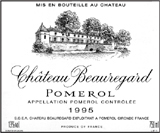
Owner: Foncier Vignobles
Address: 33500 Pomerol
Telephone: 05 57 51 13 36; Telefax: 05 57 25 09 55
E-mail: pomerol@chateau-beauregard.com
Website: www.chateau-beauregard.com
Visits: Monday to Friday 9 A.M.–noon and 2–5 P.M.
Contact: Vincent Priou
VINEYARDS
Surface area: 43.2 acres
Grape varietals: 70% Merlot, 30% Cabernet Franc
Average age of vines: 30 years
Density of plantation: 6,000 vines per hectare
Average yields: 43 hectoliters per hectare
Elevage: Three to five week fermentation and maceration in temperature-controlled stainless steel vats. A proportion of the wine undergoes malolactics (at 20° C) in barrel. Sixteen to 22 months aging in barrel with 60–80% new oak. Fining with egg whites if necessary, no filtration.
WINES PRODUCED
Château Beauregard: 60,000 bottles
Le Benjamin de Beauregard: 30,000 bottles
Plateau of maturity: Within 5–12 years of the vintage
GENERAL APPRECIATION
Never one of the biggest or most concentrated Pomerols, Beauregard is good as opposed to great. Soundly made with a low-key profile, it is reliable, typical of its appellation in terms of roundness, fruitiness, and early accessibility. However, because of its relative lightness, it is a candidate for near-term consumption rather than for long-term aging. Beauregard is one of the most realistically priced Pomerols.
As one leaves the tiny village of Catusseau, the vineyards of Beauregard are situated on the southern perimeter of the plateau of Pomerol. This is one of the few properties in the appellation that actually has a building grand enough to be called a château. The vineyard has significant potential. Most Pomerol observers consider the deep, gravelly soil to be ideal for producing high-quality wine. Until the mid-1980s, most of the vintages produced quick-to-age, rustic wines. Since, Beauregard has been making finer wine, with better color and more ripeness and concentration. Moreover, greater attention is also being paid to sanitary conditions in the cellar. The Clauzel family sold the property in 1991 to Crédit Foncier de France, and the progression in quality has continued under administrator Michel Garat and his oenologist, Vincent Priou.
IMPORTANT VINTAGES
2001 |
A low-acid, deep ruby–colored effort, the 2001 Beauregard does not offer much complexity, but it possesses abundant fruit in its medium-bodied, forward personality. Although straightforward and lacking substance, it is a savory, round, sensual Pomerol for drinking during its first 10–11 years of life. Last tasted, 1/03. |
2000 |
This up-and-coming Pomerol estate has fashioned a potentially outstanding 2000 revealing the vintage’s wonderful sweetness as well as a dense purple color, an opulent texture, a layered, concentrated mid-palate, and moderate tannin in the impressively deep, structured finish. It will require a few years of bottle age. Anticipated maturity: 2005–2016. Last tasted, 1/03. |
1999 |
An excellent wine for the vintage, this consumer-friendly Pomerol exhibits a deep ruby color along with a sweet nose of cola, mocha, cherry jam, and new oak. The wine is dense and round with an excellent texture, a big succulent mid-palate, and a long, lightly tannic finish. It should be accessible very soon. Anticipated maturity: now–2014. Last tasted, 3/02. |
1998 |
The deep ruby/purple–colored 1998 Beauregard exhibits a perfume of smoke, black cherry cough syrup, chocolate, and smoky wood. Thick, tannic, and medium to full-bodied, it will keep for 12 years. Last tasted, 3/02. |
1997 |
Another sexy, open-knit, elegant, sweet, round, short-lived, but pleasurable Pomerol, the 1997 Beauregard offers abundant grilled herbs, toasty oak, and black cherry fruit aromas and flavors. Medium bodied and supple, it is ideal for drinking over the next 3–4 years. Last tasted, 3/01. |
1996 |
Beauregard’s deep ruby–colored 1996 reveals a sweet, jammy cherry–scented nose with noticeable strawberry notes. The wine is medium bodied, soft, elegant, and moderately weighty with hints of toasty new oak. It should drink well for 2–4 years. Last tasted, 1/01. |
1995 |
An excellent wine, this 1995 offers an alluring deep ruby color with a smoky, vanilla, berry, chocolaty-scented nose. Medium bodied and ripe with sweet fruit, moderate tannin, and low acidity, this is a fine example of Beauregard. Anticipated maturity: now–2010. Last tasted, 11/97. |
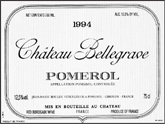
Owner: Jean-Marie Bouldy
Address: “René,” 33500 Pomerol
Telephone: 05 57 51 20 47; Telefax: 05 57 51 23 14
Visits: By appointment only
Contact: Jean-Marie or Pascale Bouldy
VINEYARDS
Surface area: 20.3 acres
Grape varietals: 75% Merlot, 25% Cabernet Franc
Average age of vines: 35 years
Density of plantation: 6,000 vines per hectare
Average yields: 45 hectoliters per hectare
Elevage: Three to four-week fermentation and maceration in temperature-controlled stainless-steel vats. Fourteen to eighteen months aging in barrels with 30–40% new oak. Fining and filtration only if necessary.
WINES PRODUCED
Château Bellegrave: 35,000–40,000 bottles
Château des Jacobins: 8,000–14,000 bottles
Plateau of maturity: Within 3–8 years of the vintage
GENERAL APPRECIATION
While this estate does not benefit from the finest terroirs of the appellation, year in and year out it manages to produce wines that range from good to very good in the best vintages. Bellegrave is generally straightforward, lacking in finesse and complexity (is that due to the sandy soils it emerges from?), but it delivers sufficient fruit and roundness. Because of its lightness and sometimes lack of concentration, it is not meant for long-term aging.
The Bellegrave vineyard, located west of RN 89, on light, sandy, gravelly soil, produces soft, easy to drink, and easy to understand wines that must be consumed in their youth. It would appear that the proprietor, Jean-Marie Bouldy, has a sensible view of what he is able to achieve in one of the less promising soil types of Pomerol. The results are cleanly made, fresh, fruity wines with mass appeal.
IMPORTANT VINTAGES
2001 |
Dark ruby with an attractive bouquet of sweet berry fruit, caramel, as well as a touch of vanilla, this medium-bodied, moderately tannic, vibrant, low-keyed, restrained Pomerol is cleanly made and deliciously fruity. Anticipated maturity: 2005–2012. Last tasted, 1/03. |
2000 |
An excellent, beefy Pomerol, this dark ruby/purple–colored wine has depth, medium to full body, a layered palate feel, and some tannin to shed. A substantial wine for this estate, it should age well. Anticipated maturity: 2007–2015. Last tasted, 1/03. |
1998 |
Surprisingly soft and open-knit, without the power and tannin often present in this vintage, this dark ruby–colored 1998 displays round, fruity flavors (primarily spice and cherries) and good weight, but not the overall charm found in the 1997. It will require consumption during its first 7–8 years of life. Last tasted, 3/01. |
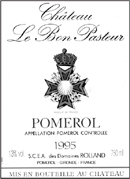
Owner: SCEA Rolland
Address: “Maillet,” 33500 Pomerol
Telephone: 05 57 51 23 05; Telefax: 05 57 51 66 08
Visits: By appointment only
Contact: Dany Rolland
VINEYARDS
Surface area: 16.4 acres
Grape varietals: 80% Merlot, 20% Cabernet Franc
Average age of vines: 30 years
Density of plantation: 6,000 vines per hectare
Average yields: 37 hectoliters per hectare
Elevage: Twenty-five to thirty-five day maceration and fermentation in small temperature-controlled tanks of 70 hectoliter capacity. Wines undergo malolactics in barrel. Fifteen to twenty months aging in 100% new oak. No fining, no filtration.
WINES PRODUCED
Château Le Bon Pasteur: 30,000 bottles
No second wine is produced.
Plateau of maturity: Within 5–20 years of the vintage
GENERAL APPRECIATION
Le Bon Pasteur is the property of Michel Rolland, the world-famous oenologist from Libourne. The style of the wines produced is unfairly controversial, but I suspect this has more to do with the man behind the estate than with the intrinsic quality of the wines. I consider Le Bon Pasteur one of the finest Pomerols. Irrespective of vintage conditions, it is always seductive (presumably because of its low acidity—a trait criticized by its detractors) and characterized by a round, rich, generous, and ripe fruit (cynical tongues argue this sur-maturité ruins the terroir character) and a close-to-perfect equilibrium. A must buy.
Le Bon Pasteur is the property of two of Bordeaux’s most gifted oenologists, Dany and Michel Rolland, who have a laboratory in Catusseau. Additionally, Michel boasts a list of clients that reads like a Who’s Who of Pomerol, St.-Emilion, and the other major appellations of Bordeaux. His fame is such that he has been retained as the consultant for many of the world’s leading wineries, from Ornellaia in Italy to Casa Lapostolle in Chile, to the renowned Napa Valley treasures of Harlan Estate and Bryant Family Vineyard.
Michel Rolland’s success, as well as the formation of an association of Pomerol estates called the Circle of Prestige of Pomerol, has given rise to two prevailing schools of thought about harvest dates and winemaking philosophies. One school—represented by the firm of Jean-Pierre Moueix and its two leading spokespeople, Christian Moueix and their cautious oenologist, Jean-Claude Berrouet—believes that the Merlot grape should not be picked too late. Their argument is that early harvesting is essential to preserve the wine’s stability and acidity. Furthermore, Moueix and Berrouet believe in shorter maceration periods to give the wines more elegance. At times, Berrouet seems almost fearful of too much flavor or hedonistic qualities in wine.
In contrast, Michel Rolland and his colleagues believe in harvesting as late as possible in order to obtain fruit that has an element of sur-maturité (overripeness). Rolland also believes in extended macerations to produce wines of profound color, richness, and aging potential. There is no doubt that Rolland’s philosophy has caught the fancy of some of France’s leading writers, particularly the outspoken Parisian Michel Bettane, probably Europe’s finest taster and wine critic. He is a solid defender of Rolland, who he believes possesses the philosophy necessary to produce extraordinary wines. Interestingly, three of Rolland’s clients, Clos l’Église, Clinet, and La Fleur de Gay, are now turning out wines that can compete with Pétrus.
Coincidentally or not, Rolland’s philosophy is winning more converts. Most of the hot shot gurus of winemaking in Bordeaux are true believers of Rolland. This includes Gerard Perse, Jean-Luc Thunevin, Stéphane Derénoncourt, Hubert de Boüard and Alain Raynáud.
The Le Bon Pasteur vineyard is not one of the best situated in Pomerol. The 16.4 acres are spread out in northeast Pomerol, near the village of Maillet. There are essentially two soil types, one gravel based and the other clay based, as well as lighter, deep gravel beds. Because of the extremely old vines, late picking, long maceration, and the use of 100% new oak, Rolland gets as much out of his vineyard as is possible. He made extraordinary wines in vintages such as 2001, 2000, 1998, 1995, 1990, 1989, 1988, and 1982. If the truth be known, the 1982, which remains celestial, validates Rolland’s philosophy.
IMPORTANT VINTAGES
2001 |
A strong effort, Le Bon Pasteur’s 2001 is nearly as fine as the sensational 2000. An opaque ruby/purple color accompanies subtle notes of charcoal, mocha, and black cherry liqueur intermixed with plums and blackberries. This ripe, impressively textured, low-acid, vibrant, well-defined Pomerol displays more uplift and freshness than the 2000, but less weight, mass, and power. A beautiful, elegant effort from this well-known overachiever, it will be at its finest between 2005–2016. Last tasted, 1/03. |
2000 |
Undeniably the finest Le Bon Pasteur since both the 1998 and 1982, the 2000 exhibits notes of roasted herbs, crème de cassis, cherry liqueur, new oak, and mocha. Powerful and intense, with moderately high tannin, a layered mid-palate, beautiful sweetness, and well-integrated wood, this low-acid, large-scaled effort is a brilliant wine from a terroir that can only produce wines of such quality because of the talents and efforts of the proprietors. Anticipated maturity: 2006–2017. Last tasted, 1/03. |
1999 |
A superb effort for the vintage, Le Bon Pasteur has produced a dense, ruby/purple-colored wine with an intriguing perfume of espresso, sweet vanilla, and black cherry jam. Powerful and concentrated for a 1999, this medium-to full-bodied, moderately tannic Pomerol is atypically structured with plenty of grip, length, and intensity. Anticipated maturity: 2005–2016. Last tasted, 3/02. |
Undoubtedly one of the finest Le Bon Pasteurs (along with the 2000, 1990, and 1982), the dense purple–colored 1998 boasts a beautifully rich, complex perfume of blackberries, plums, lead pencil, cherries, mocha, and caramel. Powerful and rich, with a multilayered texture and an opulent, viscous finish revealing enough sweet tannin for definition, this is a terrific, full-bodied, seamless effort. Anticipated maturity: now–2016. Last tasted, 3/02. |
|
1997 |
Readers looking for a delicious chocolate, smoky, cherry, black currant, and plum-scented and flavored wine will admire the fleshy, open-knit, medium-bodied 1997 Le Bon Pasteur. Seamless and smooth, with surprisingly fine concentration, it is reminiscent of a 1987, but with more muscle and richness. Drink it over the next 5–6 years. Last tasted, 1/01. |
1996 |
Le Bon Pasteur’s 1996 reveals dry, slightly gritty tannin in the finish, which kept my score more conservative. It exhibits spicy new oak, medium body, abundant smoky, black cherry, and mocha-tinged fruit, good weight, excellent purity, and a firm, structured, muscular finish. This wine should evolve nicely for 7–8 years. Last tasted, 3/00. |
1995 |
This wine offers a dark plum color and high-quality aromatics consisting of toast, lead pencil, mocha, smoke, and black cherry and currant fruit. In the mouth, this is a sweet, medium-bodied, round, spicy, succulently textured Le Bon Pasteur with a plump, fleshy finish that lasts at least 25 seconds. Anticipated maturity: now–2015. Last tasted, 10/02. |
1994 |
A telltale Merlot/Pomerol nose of mocha, chocolate, tobacco, and sweet black cherry/plummy fruit is followed by a medium-bodied wine with moderate tannin, excellent purity, outstanding richness, and a sweet finish. Anticipated maturity: now–2012. Last tasted, 1/97. |
1990 |
For current drinking, this is one of my favorite Le Bon Pasteurs. It has put on weight in the bottle and now exhibits a dark plum/garnet color with a bit of lightening at the edge. The huge, almost intoxicating nose of fruitcake and sweet, jammy, red and black fruits intermixed with mocha and caramel soars from the glass. In the mouth notes of espresso are joined with a concoction of fruit that is full-bodied, loaded with glycerin, and very succulent, fleshy, and hedonistic. It is a wine of considerable pleasure, yet it seems to be becoming delineated and complex as it ages. Anticipated maturity: now–2010. Last tasted, 6/02. |
1989 |
This wine has reached full maturity very quickly. The wine shows some amber at the edge, with a sweet nose of roasted coffee intermixed with caramel, mocha, black cherry, and tobacco. The wine is medium bodied and beautifully sweet and fleshy on the attack, but then narrows out ever so slightly in the mouth. There remains some tannin to be resolved. Anticipated maturity: now–2014. Last tasted, 12/02. |
1988 |
A very powerful Le Bon Pasteur with more obvious tannin than most vintages, this nicely structured, still surprisingly youthful wine shows notes of cigar smoke intermixed with mocha, caramel, coffee, earth, truffle, and black cherry. The wine is still relatively dense and garnet in color, with no lightening at the edge. Medium bodied with firm tannin in a more structured and muscular style than most Le Bon Pasteurs, this wine can be drunk now but promises to age easily for at least another decade. Anticipated maturity: now–2018. Last tasted, 6/02. |
1986 |
Close to full maturity, this effort is more sinewy and austere than most Le Bon Pasteurs, but has a complex nose of cola, herbs, coffee, and sweet kirsch. The wine is medium bodied, slightly edgy, with some dry tannins noticeable in the finish. I expect this wine will not get any better, although it certainly has the structure to last for at least another decade. Anticipated maturity: now–2010. Last tasted, 6/02. |
Starting to show some cracks around the edges, this Le Bon Pasteur has considerable amber at the edge of its dark ruby/garnet color. The wine has an herbaceous nose intermixed with cedar wood, sweet plums, prunes, and cherries. The wine is medium bodied, and shows some elements of dilution in the finish, which is a bit thin and attenuated. Drink it up. Last tasted, 6/02. |
|
1983 |
In decline, this wine is showing notes of ashtray, dried earth, smoke, and damp earth. Mushroomy notes have also become apparent, and the wine seems to be losing its fruit at a relatively accelerated pace. This medium-bodied, somewhat attenuated wine is showing increasing evidence of desiccation. It needs to be drunk up. Last tasted, 6/02. |
1982 |
Consistently one of the most magnificent 1982s in the vintage that brought Le Bon Pasteur and Michel Rolland to the world stage, this wine, last tasted at a blind tasting in October 2002, was spectacular and was the group favorite over some of the top wines of the vintage. I had the wine on seven occasions in 2002, since it was the 20th anniversary of the vintage and there were many, many 1982 tastings. I thought the wine had hit its peak, and I still believe that, but the wine continues to amaze me with its vibrancy and freshness. The color is a dark garnet with some amber creeping in at the edge. The nose is simply spectacular, an ice-cream fountain smorgasbord of roasted nuts, chocolate, mocha, toffee, and sweet black cherries, plums, and currants intermixed with spice box and cedar. It is very full-bodied, expansive, opulent, and lush, yet light on its feet. This wine is a spectacular confirmation of the winemaking philosophy of Michel Rolland and his wife, Dany. Out of magnum and larger formats, I am sure this wine can go on for another 15 or more years, but I still would not tempt fate—I am assuming that every time I have had it, it has been from pristinely stored bottles. Anticipated maturity: now–2010. Last tasted, 10/02. |
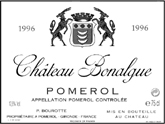
Owner: Pierre Bourotte
Address: Rue de Bonalgue, 33500 Libourne
Mailing address: Pierre Bourotte SA, BP 79, 6é, quai du Priourat, 33502 Libourne
Telephone: 05 57 51 62 17; Telefax: 05 57 51 28 28
E-mail: jeanbaptiste.audy@wanadoo.fr
Visits: By appointment only
Contact: Pierre Bourotte
VINEYARDS
Surface area: 16 acres
Grape varietals: 85% Merlot, 15% Cabernet Franc
Average age of vines: 25 years
Density of plantation: 6,000 vines per hectare
Average yields: 48 hectoliters per hectare
Elevage: Four-week fermentation and maceration in temperature-controlled stainless-steel vats. Fifteen to sixteen months aging in barrels with 50–60% new oak. Fining and filtration.
Château Bonalgue: 28,000–30,000 bottles
Château Burgrave: 9,000 bottles
Plateau of maturity: Within 4–10 years of the vintage
GENERAL APPRECIATION
Bonalgue is always good and soundly made. Made in a lighter style, it offers sweet fruit and presents an elegant character that makes up for its lack of complexity. In view of its reasonable pricing, it qualifies as one of the best bargains in Pomerol.
Bonalgue remains a relatively obscure Pomerol, but the quality is consistently sound and, in top vintages, very good. The vineyard, situated on a mixture of gravelly and sandy soil just at the entrance of Libourne, behind the racetrack on RN 89, turns out deeply colored, chunky, fleshy wines that lack complexity, but not character, fruit, or mouth-filling pleasure. Proprietor Pierre Bourotte is one of Pomerol’s consummate gentlemen; he is also the owner of Clos du Clocher.
IMPORTANT VINTAGES
2001 |
Another excellent effort from this perennial reasonably priced overachiever, the plump, fat, juicy 2001 Bonalgue exhibits a saturated ruby/purple color as well as sweet mocha and black cherry liqueur-like aromas, a layered attack, and sweet tannin in the finish. This luscious sleeper of the vintage will drink well during its first 10–12 years of life. Last tasted, 1/03. |
2000 |
The 2000 may be the finest wine this estate has produced. Its dense purple color is accompanied by aromas of figs, blackberries, and cherries, low acidity, a voluptuous texture, and excellent concentration. There are no hard edges in this seamless, bigger than usual Bonalgue. Anticipated maturity: now–2014. Last tasted, 1/03. |
1999 |
A very good effort, the deep ruby/purple–colored 1999 Bonalgue offers mocha-infused, sweet black cherry fruit, low acidity, excellent texture, and a plump, fleshy finish. It is expressive as well as hedonistic. Anticipated maturity: now–2009. Last tasted, 1/03. |
1998 |
Deep ruby/purple–colored, with a ripe nose of black cherries, earth, underbrush, smoke, and mocha, the 1998 is dense, chewy, and succulent, with oodles of fruit as well as glycerin. A fleshy, up-front character will provide appeal over the next eight years. Last tasted, 3/02. |
1997 |
A jammy, prune, raisiny, sweet cherry–scented bouquet jumps from the glass of this medium ruby–colored wine. Attractive, soft, and diffuse, this medium-bodied effort requires consumption sooner than later. Last tasted, 1/01. |
1996 |
The 1996 is a well-made wine. It offers up a sweet nose of plum fruit intertwined with cherries. Sweet fruit, good fat, and a touch of oak give the wine a plump, savory mouth-feel. This is a charming, bistro-styled red with more depth and ripeness than many wines costing twice as much. Drink it over the next 3–4 years. Last tasted, 3/01. |
1995 |
A dark ruby–colored wine with sweet, spicy, berry fruit and a roasted peanut– scented nose, the 1995 Bonalgue is soft, round, and velvety textured, with low acidity and moderate weight. It is an attractive wine for near-term drinking. Anticipated maturity: now. Last tasted, 12/00. |
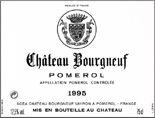
Owner: Xavier Vayron
Address: 1, le Bourg Neuf, 33500 Pomerol
Telephone: 05 57 51 42 03; Telefax: 05 57 25 01 40
E-mail: chateaubourgneufvayron@wanadoo.fr
Visits: By appointment
Contact: Xavier or Dominique Vayron
VINEYARDS
Surface area: 22.2 acres
Grape varietals: 90% Merlot, 10% Cabernet Franc
Average age of vines: 40 years
Density of plantation: 6,000 vines per hectare
Average yields: 38–40 hectoliters per hectare
Elevage: Three to four week fermentation and maceration in temperature-controlled concrete vats with daily pumpings-over. Fifteen months aging in barrels with 40% new oak. Fining, filtration depending upon the vintage.
WINES PRODUCED
Château Bourgneuf Vayron: 48,000 bottles
Plateau of maturity: Within 5–15 years of the vintage
GENERAL APPRECIATION
The quality level at this estate has improved immensely since the mid-1990s. While Bourgneuf Vayron produced average efforts in the past (vintages prior to 1994 need to be considered with caution), it has come forward with a new style of vinification and now offers wines that are concentrated, rich, and generous, but also reveal a ruggedness and coarseness that the proprietors have not been able to tame.
Given the well-situated position of Bourgneuf Vayron’s vineyard in the center of the appellation on the plateau just to the west of Trotanoy, it has always puzzled me why higher-quality wines do not emerge from this estate. The ruggedly impressive wines that have emerged since 1995 do seem to suggest better things. The production yields are reasonable and, when talking to the proprietors, it is clear that they pay a great deal of respect to a traditional vinification. This estate has been in the Vayron family since 1821. A property that is clearly on the rise, Bourgneuf Vayron merits more and more consumer interest.
IMPORTANT VINTAGES
2001 |
Although less rustic than previous efforts, the 2001 Bourgneuf Vayron is a well-endowed, rich Pomerol displaying an impenetrable ruby/purple color as well as huge fruit and body. The 2001 has it more elegance and charm than usual without sacrificing its blockbuster mouthful of Claret style. Anticipated maturity: 2008–2018. Last tasted, 1/03. |
This wine lacks refinement, but for readers seeking an exuberant, rustic, muscular, robust, concentrated Claret, there is a lot to enjoy in it. The 2000 Bourgneuf Vayron has put on weight, but it still possesses brutally high tannin. However, the muscle, extract, and bigness are impressive in a powerful, unrefined manner. Cellaring may bring more sophistication and elegance, but for now, this is a dark and gothic wine. Anticipated maturity: 2007–2020? Last tasted, 1/03. |
|
1999 |
Dark ruby–colored with notes of scorched earth intermixed with Provençal herbs, plums, and chocolate, this medium-bodied wine is spicy and dense, with astringent tannin in the finish. If the tannin becomes better integrated without a loss of fruit, it will merit its excellent rating and last for 12+ years. Last tasted, 3/02. |
1998 |
A dense, saturated ruby/purple color is followed by aromas of green peppercorns, plums, roasted meat, leather, tobacco, and black fruits. The wine is chunky, full-bodied, concentrated, and chewy, with tough tannin in the finish. If the green pepper component becomes better integrated and the tannin melts away, this 1998 will merit an outstanding rating, but patience will be required. Is this a wine for those with 19th century tastes? Anticipated maturity: 2006–2020. Last tasted, 3/02. |
1997 |
A strong, albeit rustic effort, this opaque dark ruby/purple–colored 1997 reveals herbaceous black cherry, earthy, licorice aromas, a tannic, medium-to full-bodied, chewy constitution, and less charm than most 1997s, but more weight, intensity, and volume. Let’s hope the tannin will become better integrated. Anticipated maturity: now. Last tasted, 3/00. |
1996 |
The 1996 has turned out well, although it is somewhat monolithic. The color is saturated ruby/plum. The wine has an earthy, black cherry, licorice, and dried herb–scented nose, medium to full body, and muscular, concentrated flavors with moderately high tannin. It is a mouth-filling, robust Pomerol to drink between now and 2012. Last tasted, 12/01. |
1995 |
A sleeper of the vintage, Bourgneuf Vayron’s 1995 has an opaque purple color. The wine offers a closed but promising nose of black cherries, raspberries, and coffee-tinged fruit. Packed and stacked, as they say in the vernacular, this medium-to full-bodied, powerful, mouth-filling Pomerol is big, bold, and boisterous. This excellent, decadently rich wine will be at its apogee until 2014. Last tasted, 3/00 |
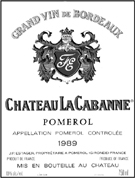
Owner: Estager family
Address: route de La Cabanne, 33500 Pomerol
Mailing address: SCEA des Vignobles J.-P. Estager, 33–41, rue de Montaudon, 33500 Libourne
Telephone: 05 57 51 04 09; Telefax: 05 57 25 13 38
E-mail: estager@estager.com
Website: www.estager.com
Visits: By appointment only
Contact: Mrs. Estager
Surface area: 24.7 acres
Grape varietals: 94% Merlot, 6% Cabernet Franc
Average age of vines: 25 years
Density of plantation: 5,000 vines per hectare
Average yields: 48 hectoliters per hectare
Elevage: Cold maceration, three to four week fermentation, and maceration in temperature-controlled stainless-steel vats. After completion of malolactics, 14–18 months aging with 60% new oak. Fining, filtration depending upon the vintage.
WINES PRODUCED
Château La Cabanne: 54,000 bottles
Domaine de Compostelle: variable
Plateau of maturity: Within 5–12 years of the vintage
GENERAL APPRECIATION
In theory, the wines of La Cabanne seem to be soundly made, but in practice they often turn out to be disappointedly thin, overly tannic, and oaked, without the generosity of fruit found in the best Pomerols or from a Merlot-based wine. Despite these traits, this wine has its followers.
La Cabanne is run by the Estager family. In addition to owning Château La Cabanne, they also own property in Montagne-St.-Emilion (Château La Papeterie) and lease another estate in Pomerol (Château Haut-Maillet). La Cabanne, whose sizable production is distributed internationally, represents a solidly made, plump Pomerol that offers rustic aromas of dusty, cedary, plummy fruit, followed by a generous yet often coarse texture that can lack finesse and be overcharged with tannin and undercharged with fruit. Nevertheless, if never dazzling, it is a reliably made wine that can stand the test of time. The vineyard is highly morseled, but the château itself is situated in the heart of Pomerol, not far from the famed Château Trotanoy.
IMPORTANT VINTAGES
None of my tasting notes have ever scored the wines above 85–86, and therefore I have not included them in this book. For those who think I have been too conservative, they may want to take a look at La Cabanne’s 2000, 1998, 1990, and 1989.


Owner: Ets Jean-Pierre Moueix
Address: 33500 Pomerol
Mailing address: c/o SA Ets Jean-Pierre Moueix, BP 129, 54, quai du Priourat, 33502 Libourne
Telephone: 05 57 51 78 96; Telefax: 05 57 51 79 79
Visits: By appointment and exclusively for professionals of the wine trade dealing with the firm
Contact: Frédéric Lospied
VINEYARDS
Surface area: 8 acres
Grape varietals: 100% Merlot
Average age of vines: 20 years
Density of plantation: 6,250 vines per hectare
Average yields: 38 hectoliters per hectare
Elevage: Twenty day fermentation and maceration in temperature-controlled concrete tanks. Eighteen months aging in barrels with 30% new oak. Fining, no filtration.
WINES PRODUCED
Château Certan Marzelle: 12,000 bottles
Plateau of maturity: Within 5–10 years of the vintage
GENERAL APPRECIATION
Judging by its short history, this estate belonging to the Libourne-based firm of JP Moueix has only two vintages to evaluate. It is vinified by the same technical team that cares for such stars as Pétrus, Hosanna, and Trotanoy, and the vineyard is well placed in Pomerol.
A new wine launched by Christian Moueix, Certan Marzelle comes from a parcel of the original Certan-Giraud vineyard. The finest section of that vineyard was renamed Hosanna, another parcel was sold to Nenin, and the third parcel was resurrected to create this 100% Merlot offering. Sadly, there are only 1,000 cases of this effort, which may be Christian Moueix’s answer to the famed Le Pin.
IMPORTANT VINTAGES
2001 |
A crisp, cool-climate style of Pomerol, the dark ruby–colored 2001 has cherry and red currant fruit interwoven with underbrush and herb notes. Medium bodied with good tannin and a well-delineated personality, this restrained yet supple as well as meaty Pomerol will need to be drunk early on. Anticipated maturity: 2004–2012. Last tasted, 1/03. |
2000 |
The debut vintage for this 100% Merlot cuvée is strikingly precocious and sexy. This, lush, soft, supple, disarming wine exhibits a deep ruby/purple color followed by a sweet, expressive flavors of cocoa, cherry liquor and a fleshy, full-bodied texture. This is a total hedonistic turn-on. Anticipated maturity: now–2014. Last tasted, 1/03. |
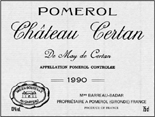
Owner: Odette Barrau-Badar
Address: 33500 Pomerol
Telephone: 05 57 51 41 53; Telefax: 05 57 51 88 51
Visits: By appointment only
Contact: Jean-Luc Barrau
VINEYARDS
Surface area: 12.3 acres
Grape varietals: 70% Merlot, 25% Cabernet Franc, 5% Cabernet Sauvignon
Average age of vines: 25 years
Density of plantation: 5,500 vines per hectare
Average yields: 40 hectoliters per hectare
Elevage: Four to five week fermentation and maceration in temperature-controlled stainless-steel tanks with frequent pumpings-over. Fourteen to sixteen months aging in barrels with 70% new oak. Fining, no details regarding filtration.
WINES PRODUCED
Château Certan de May: 24,000 bottles
Plateau of maturity: Within 6–20 years of the vintage
GENERAL APPRECIATION
This estate, which benefits from a remarkable situation, is extremely famous for its older vintages, especially those of the 1940s and 1950s. It also did well in the 1980s. After a slump in the 1990s, it now seems to be rebounding.
This tiny gem of a vineyard has become a star in the Pomerol firmament. Certan de May’s vineyard is superbly located on the highest ground of Pomerol, right between Vieux Château Certan and Pétrus. For years the wine was made by another château, but since 1974 the present proprietors, Madame Odette Barrau-Badar and her son, Jean-Luc, have been responsible for every detail. The result has been a series of remarkably rich, concentrated Pomerols that make Certan de May one of this appellation’s most interesting wines. That said, in the 1990s, Certan de May, for unknown reasons, became increasingly herbaceous and less concentrated.
There are a number of reasons why Certan de May has emerged as one of Pomerol’s most promising wines since 1976. In 1976 the old wooden fermentation vats were replaced with stainless-steel. Additionally, the increasing responsibilities given to Jean-Luc Barrau have resulted in several decisions that no doubt account for the higher quality of Certan de May. This estate believes in harvesting as late as possible. Also, the extremely long maceration—nearly one month—insures that the wines are super-extracted, opaque black/purple–colored, and loaded with tannin for a long evolution. The use of 70% new oak casks seems to result in the perfect marriage between new oak and the ripe, concentrated fruit obtained by Certan de May.
However, this is not a Pomerol that can be drunk young. Most top vintages since the mid-1970s have needed at least 7–10 years of bottle age before they have exhibited a great deal of development. Sadly, the estate’s increasingly irregular performance over the last 10–15 years must be considered.
IMPORTANT VINTAGES
ANCIENT VINTAGES
Since the last edition of this book, I have not seen any extremely old vintages of Certan de May. As I indicated in the last edition, the 1945 (96 points; last tasted 10/94) was a spectacular wine that still had 20 years of life left in it.
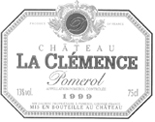
Owner: Anne-Marie Dauriac
Address: 33500 Pomerol
Mailing address: c/o SC Dauriac, Château Destieux, 33330 St.-Emilion
Telephone: 05 57 40 25 05 or 05 57 24 77 44; Telefax: 05 57 40 37 42
Visits: By appointment only
Contact: Anne-Marie Dauriac (05 57 40 10 23)
VINEYARDS
Surface area: 7.4 acres
Grape varietals: 85% Merlot, 15% Cabernet Franc
Average age of vines: 45 years
Density of plantation: 6,000 vines per hectare
Average yields: 20 hectoliters per hectare
Elevage: Fermentation and maceration in temperature-controlled wooden vats. Wines undergo malolactics and are aged 18–20 months in new oak barrels. No fining, no filtration.
WINES PRODUCED
Château La Clémence: 7,000 bottles
Plateau of maturity: Within 5–18 years of the vintage
GENERAL APPRECIATION
This newly created garage operation is ambitious. It is too soon to predict whether the wines will live up to expectations. However, knowing the superb work proprietors Christian and Anne-Marie Dauriac have accomplished at Destieux, their St.-Emilion property, one can assume no effort will be spared to propel La Clémence to the top echelon of Pomerols. For the time being, the debut is encouraging, but prices are steep.
Produced from a vineyard planted with old-vine Merlot and Cabernet Franc (yields are a meager 20 hectoliters per hectare), La Clémence receives the full garage wine treatment. The 2000 is the first vintage that Christian Dauriac (Destieux’s proprietor) has released.
IMPORTANT VINTAGES
2001 |
I tasted the 2001 La Clémence on three separate occasions. On two of them, I thought the wood was overdone and the wine slightly disjointed. However, there is no doubting the exciting levels of concentration, thickness, and richness. There is considerable substance, a layered, opulent mid-palate, exceptional purity as well as length, and loads of blackberry and cherry fruit, but the wood is aggressive and obtrusive. My instincts suggest lees aging will lessen the noticeable new oak. As it fills out and gains more harmony, this 2001 should merit a score in the low 90s. Anticipated maturity: 2005–2016. Last tasted, 1/03. |
2000 |
The full-bodied, super-extracted 2000 La Clémence boasts a deep opaque purple color as well as a gorgeous perfume of sweet blackberry and cherry fruit intertwined with vanilla and spice. While long, concentrated, and powerful, it has not lost its sense of place or purpose. Anticipated maturity: 2005–2018. Last tasted, 1/03. |
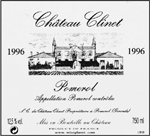
Owner: Jean-Louis Laborde
Address: route de Feytit, 33500 Pomerol
Mailing address: 3, rue Fénelon, 33000 Bordeaux
Telephone: 05 56 79 12 12; Telefax: 05 56 79 01 11
E-mail: contact@wines.uponatime.com
Website: www.wines.uponatime.com
Visits: By appointment only
Contact: Eric Herguido
Surface area: 22.2 acres
Grape varietals: 85% Merlot, 10% Cabernet Franc, 5% Cabernet Franc
Average age of vines: 40 years
Density of plantation: 6,600 vines per hectare
Average yields: 35 hectoliters per hectare
Elevage: Thirty to forty day fermentation and maceration in temperature-controlled wooden vats of small capacity. Eighteen to twenty-four months aging in 100% new oak barrels. No fining, no filtration.
WINES PRODUCED
Château Clinet: 28,000 bottles
Fleur de Clinet: 12,000 bottles
Plateau of maturity: Within 7–18 years of the vintage
GENERAL APPRECIATION
Over recent years, Clinet has never attained the quality of the nearly perfect 1990 and 1989, but it continues to produce one of the finest Pomerols. The wine is generally difficult to understand and approach in its youth (it is extremely closed and tannic in infancy), but it reveals itself beautifully after some 5–8 years aging, when it shows nicely melted tannins and fully reveals the sheer generosity and roundness that characterize the best Pomerols.
One of the appealing arguments often offered for the quality of a wine is the notion of terroir, that magical sense of a vineyard’s soil giving a wine a particular character. However, Clinet, which does indeed possess a magnificent terroir at the summit of the plateau of Pomerol (not more than one-half mile from such superstars as Lafleur and Pétrus and immediately adjacent to L’Eglise-Clinet), is an example where a dedicated man proved that the human commitment to quality can have greater influence than just relying on the vineyard’s soil to turn out high-quality wine.
I am speaking of the late Jean-Michel Arcaute, who married the daughter of the proprietor, George Audy. In 1986 Arcaute assumed control of Clinet and in less than four years he took this perennial underachiever to the very top of the Pomerol hierarchy. How did he do it? First, the famed oenologist Michel Rolland was given full responsibility regarding picking dates and style of vinification and élevage. This meant that Clinet would be harvested as late as possible. In fact, since 1987 the vineyards of Clinet have been among the last harvested in Pomerol. Moreover, the use of mechanical harvesters, utilized first with the 1982 vintage, was discontinued. The results have been a 1987 that is probably not only the wine of the appellation, but may well be one of the two best wines produced in the vintage (the other being Mouton Rothschild), a glorious 1988, and compellingly great wines in 1990 and 1989. Arcaute believed in macerating Clinet for up to a month. He also reduced the onetime high percentage of Cabernet Sauvignon to just less than 15%. To the surprise of everyone in Bordeaux, the property was sold to Jean-Louis Laborde, who has quietly been rebuilding Clinet’s reputation and the pinnacle of quality it attained in 1990 and 1989.
Clinet’s performance in the early 1980s (even including the great 1982 vintage), 1970s and 1960s was abysmal. One dirty, thin, unattractive wine after another was produced, making their efforts from 1985 onward even more impressive. The only persuasively great wine I tasted was a magnum of 1947 Clinet (96 points; last tasted 12/95). I suppose from a pristinely kept bottle, this wine would still be magnificent.
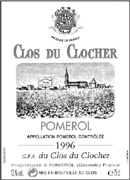
Owner: Pierre Bourotte (Audy family)
Address: Catusseau, 33500 Pomerol
Mailing address: SC Clos du Clocher, Ets J.-B. Audy, BP 79, 33502 Libourne Cedex
Telephone: 05 57 51 62 17; Telefax: 05 57 51 28 28
E-mail: jeanbaptiste.audy@wanadoo.fr
Visits: By appointment only
Contact: Pierre Bourotte
VINEYARDS
Surface area: 14.8 acres
Grape varietals: 80% Merlot, 20% Cabernet Franc
Average age of vines: 25 years
Density of plantation: 6,000 vines per hectare
Average yields: 46 hectoliters per hectare
Elevage: Four week fermentation and maceration in temperature-controlled cement tanks. Wines undergo malolactics in barrels. Eighteen months aging in barrels with 60% new oak. Fining and filtration.
WINES PRODUCED
Clos du Clocher: 21,000–22,000 bottles
Château Monregard La Croix: 12,000 bottles
Plateau of maturity: Within 5–12 years of the vintage
GENERAL APPRECIATION
Very close in style to its stablemate Bonalgue, Clos du Clocher reveals a pleasant roundness and offers a rich fruitiness and medium-bodied style that makes up for its lack of elegance and finesse. In the best vintages, Clos du Clocher merits serious attention.
A terribly under publicized property (with a fabulous terroir) situated just south of the large church that dominates the landscape of Pomerol’s vineyards, Clos du Clocher’s 2,000-case production rarely makes its way outside Europe. The savvy Belgians remain enthusiastic buyers of this wine. The vineyard, planted with 80% Merlot and 20% Cabernet Franc, produces a generously flavored, full-bodied wine that lacks some polish and finesse but is quite attractive. Clos du Clocher consistently produces very Burgundian-styled wines with a silky, supple texture that offer considerable charm and fruit.
All things considered, this is a slightly underrated Pomerol that in top vintages can produce excellent wines. Prices, however, have never been inexpensive because the tiny production is gobbled up by the enthusiastic fans of Clos du Clocher. My instincts suggest that Pierre Bourotte, capably assisted by Ludovic David, will push this property into a higher echelon of quality.
IMPORTANT VINTAGES
2001 |
An impressive effort from this well-situated Pomerol estate, the 2001 Clos du Clocher offers notes of blueberries, black cherry liqueur, and cassis in its sweet, concentrated, thick personality. Additional complexity should emerge with further aging. Medium to full-bodied, nicely textured, low in acidity, and loaded with fat and glycerin, it will be drinkable between 2004–2016. Bravo! Last tasted, 1/03. |
2000 |
One of the strongest efforts from this estate in many years, the 2000 Clos du Clocher exhibits a style reminiscent of some 1975 Pomerols . . . powerful tannin, dense concentration, and plenty of body as well as potential. A sweet, soft, surprisingly seductive effort, hedonistic and fleshy, with copious quantities of mocha and blackberry/cherry fruit in addition to a hint of caramel and coffee, this full, rich, supple wine is a candidate for two decades of aging. Anticipated maturity: 2007–2020. Last tasted, 1/03. |
1999 |
This dense, opaque purple–colored Pomerol displays surprisingly tough tannin for the vintage, but there is plenty of depth to this nearly rustic effort. It possesses admirable texture, size, and concentration, but it will require patience. Anticipated maturity: 2006–2014. Last tasted, 3/02. |
1998 |
A serious, structured, moderately tannic effort, the dense ruby/purple–colored 1998 offers aromas and flavors of black raspberries, cherries, plums, Asian spices, earth, and new oak. It possesses a fat, succulent mid-palate as well as excellent sweetness from glycerin and ripeness, and it will be at its apogee until 2015. Last tasted, 3/02. |
1997 |
A somewhat overripe style of wine that is medium bodied and fully mature, with low acidity and some tasty fig, plum, and cherry fruit intermixed with hints of tea and tomato skin, this wine needs to be drunk up. Last tasted, 12/01. |
1996 |
Fully mature, this mid-weight Pomerol has a medium ruby color with some amber at the edge, notes of balsam wood intermixed with dried herbs, sweet black cherry jam, and a hint of mocha. The wine has dropped most of its tannins and should be drunk over the next 2–3 years. Last tasted, 12/01. |
1995 |
This wine still has some noticeable tannin, but shows more weight and richness in a more backward style than the 1996. The aromatics suggest full maturity, with notes of cola, espresso, caramel, and sweet black cherry and plum fruit. In the mouth it is medium bodied with good ripeness and moderate concentration, and it has some light tannins in the finish. Anticipated maturity: now–2007. Last tasted, 12/01. |
ANCIENT VINTAGES
Since most of the vintages of Clos du Clocher need to be drunk relatively early, the best vintages that I have tasted, and I assume all of them are now either fully mature or just beginning to decline, are 1990 (87 points; last tasted 1/93), 1989 (88 points; last tasted 1/93), and 1982 (87 points; last tasted 10/02).
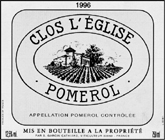
Owner: Sylviane Garcin-Cathiard
Address: 33500 Pomerol
Mailing address: c/o Château Haut-Bergey, BP 49, 33850 Léognan
Telephone: 05 56 64 05 22; Telefax: 05 56 64 06 98
E-mail: haut.bergey@wanadoo.fr
Visits: By appointment only
Contact: Hélène Garcin-Lévêque
VINEYARDS
Surface area: 14.8 acres
Grape varietals: 60% Merlot, 40% Cabernet Franc
Average age of vines: 33 years
Density of plantation: 7,100 vines per hectare
Average yields: 31 hectoliters per hectare
Elevage: Fermentation and prolonged maceration in temperature-controlled wooden vats of 60-hectoliter capacity with pigéages. Running off by gravity. Wines undergo malolactics in barrels. Eighteen months aging in 100% new oak. No fining, no filtration.
WINES PRODUCED
Clos l’Église: 15,000 bottles
Esprit de l’Eglise: 10,000 bottles
Plateau of maturity: Within 5–15 years of the vintage
GENERAL APPRECIATION
While Clos l’Église was a mediocre performer until the mid-1990s, it has rebounded beautifully afer its acquisition in 1997 by the Garcin-Cathiard family. This wine, which now stands as one of the most opulent of its appellation, is a benchmark Pomerol that can easily compete with, if not surpass, many of the stars of the right bank, including the likes of Le Pin and Pétrus.
The vineyard of Clos l’Église, one of the numerous châteaux in Pomerol with the word église in its name (because so many of the vineyards abut the large church that sits amongst the vines), is well situated on the plateau adjacent to that of Château Clinet. The entire vineyard is planted on a slope of clay and gravel with a westerly exposure. Until 1997 I had tasted some good vintages from Clos l’Église (1964 is a favorite); the relatively high percentage of Cabernet Sauvignon and Cabernet Franc formerly used in the blend tended to give the wine a Médoc-like austerity. In fact, it is this lack of richness and opulence in top vintages that causes it to come across as anorexic. In years where the Cabernet does not fully ripen, Clos l’Église can be herbaceous to the point of being vegetal. Under the new owners, the Cabernet Sauvignon has been ripped out in favor of Merlot and Cabernet Franc.
In 1997, the new proprietors hired Michel Rolland to make the wine, and the result has been a succession of brilliant wines from Clos l’Église. This transformation from ugly duckling to beautiful superstar makes the indifferent efforts of the last 30 years under the Moueix management difficult to comprehend.
IMPORTANT VINTAGES
2001 |
The 2001 Clos l’Église is a candidate for the wine of the vintage. An opaque purple color is followed by gorgeous aromas of mocha, plums, figs, black cherry liqueur, and espresso. Deep, multilayered, and textured, with extraordinary purity and palate presence, this is a stunningly rich, well-proportioned, extremely long (the finish lasts 30–35 seconds) 2001 to consume between 2007–2017. Bravo! Last tasted, 1/03. |
2000 |
I am not sure the 2000 will ultimately surpass the 1998 (a staggeringly great effort), but it appears equivalent in quality. It possesses great intensity and massive concentration, yet is extremely light and delicate. The opaque purple color is followed by a prodigious wine displaying surreal levels of extract and richness as well as a phenomenally complex bouquet of blueberry liqueur, mocha, camphor, cigar smoke, new saddle leather, plums, and roasted nuts. Amazingly pure, textured, and voluptuous, with moderately high tannin in the finish, this knockout 2000 will be at its finest between 2010–2030. Last tasted, 1/03. |
1999 |
A tremendous success for the vintage, the 1999 Clos l’Église is performing well from bottle. A stunningly complex nose of vanilla, espresso, plums, figs, charcoal, and black cherry liqueur jumps from the glass of this flamboyantly scented wine. In the mouth, it is all sex appeal, with silky, voluptuous flavors, sweet tannin, low acidity, and ripe, concentrated flavors. Drink it over the next 10–14 years; it might last even longer given its brilliant balance. Last tasted, 3/02. |
1998 |
A classic Pomerol, the 1998 boasts a superb, complex bouquet of mocha fudge, vanilla, black cherries, roasted coffee, smoke, and berries. The dazzlingly explosive aromatic display is followed by a creamy-textured, medium-to full-bodied, beautifully layered wine with no hard edges. A supple texture leads to a finish with notes of caramel and spice that lingers for more than 40 seconds. This is a gorgeous, complex Pomerol. Anticipated maturity: now–2018. Last tasted, 10/02. |
1997 |
One of the few stars of this soft, consumer-friendly vintage, Clos l’Église has fashioned a dark ruby/purple–colored, sexy wine with ostentatious aromas of mocha, fudge, coffee, and sweet berry fruit intermixed with toasty new oak. Medium to full-bodied and opulently textured, with low acidity, abundant glycerin, and lovely fruit, this is a triumph for the vintage. Drink this gorgeous Pomerol over the next 10 years. Last tasted, 6/02. |
1990 |
The 1990 is the best wine in years from this estate. It exhibits an excellent bouquet of cassis, spicy new oak, and subtle herbs. In the mouth, it is medium bodied with an attractive ripeness, elegance, and a fleshy, surprisingly rich, long finish. Drink it over the next 7–10 years. Last tasted, 1/93. |
1989 |
The 1989 is light, intensely herbaceous, and short on the palate. Anticipated maturity: now. Last tasted, 1/93. |
1988 |
The disappointing 1988, which is similar to the 1989 but with less alcohol and body, should be drunk up. Anticipated maturity: Probably in decline. Last tasted, 1/93. |
Because of the vintage, the 1986 demonstrates more class and richness than the watery, lightweight 1985. Perhaps the late-picked Cabernet Sauvignon has given the wine more depth, but it still comes up short in comparison with other Pomerols. There is an attractive oakiness, but overall this is a lightweight wine that could use more flesh and muscle. Anticipated maturity: now. Last tasted, 3/90. |
|
1985 |
I found the 1985 to be light, medium bodied, and elegant, but a little short on substance and length. Anticipated maturity: now. Last tasted, 3/90. |
1982 |
Until the new owners got serious about quality, Clos l’Église was one of my least favorite Pomerols. The 1982 Clos l’Église has never exhibited much extract, intensity, or the trademark characteristics of the vintage—sweet, expansive, ripe fruit and an opulent, chewy texture. The wine offers light-bodied, vegetal, tea-like aromas presented in a spicy, diluted format. It is in full decline. Last tasted, 10/02. |
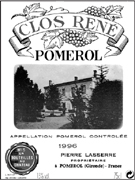
Owner: Garde-Lasserre families
Administrator: Jean-Marie Garde
Address: 33500 Pomerol
Telephone: 05 57 51 10 41; Telefax: 05 57 51 16 28
Visits: By appointment only
Contact: Jean-Marie Garde
VINEYARDS
Surface area: 29.6 acres
Grape varietals: 70% Merlot, 20% Cabernet Franc, 10% Malbec
Average age of vines: 35 years
Density of plantation: 5,500 vines per hectare
Average yields: 45 hectoliters per hectare
Elevage: Three week fermentation and maceration in temperature-controlled concrete vats. Sixteen months aging in barrels that are renewed by 25% at each vintage. Fining, no filtration.
WINES PRODUCED
Clos René, 70,000 bottles
No second wine is produced.
Plateau of maturity: Within 5–15 years of the vintage
GENERAL APPRECIATION
Though Clos René has improved since the mid-1980s, it remains a lighter styled, open-knit, supple, and accessible Pomerol. The wine is good to very good, but rarely great. Prices are reasonable.
Clos René sits well to the west of the major châteaux of Pomerol, in an area that is just south of the appellation of Lalande-de-Pomerol. The wines made in this area tend to be open-knit in style, quite fruity, supple, and easy to drink. While the style of Clos René is no exception to this rule, I have noticed a perceptible change to a wine that is a bit bigger framed, darker colored, and a little more substantial and concentrated. Perhaps the counseling of Michel Rolland, the highly respected Libourne oenologist and proprietor of Le Bon Pasteur, has made the difference. Whatever the reason, there is no doubt that some vintages of the 1980s and 1990s have produced the best wines from Clos René in recent memory. Because it is not one of the best-known Pomerols, Clos René remains reasonably priced.
IMPORTANT VINTAGES
2001 |
This dark ruby–colored, medium-weight 2001 is deficient in substance/stuffing. It offers a sweet bouquet of ripe berry fruit intermixed with herbs, wood, and underbrush. Although well made, it is superficial. Drink it over the next decade. Last tasted, 1/03. |
2000 |
A potential sleeper of the vintage, this opaque ruby/purple–colored Pomerol exhibits black fruits, coffee, and praline characteristics with hints of sweet oak. Fleshy, with excellent richness and more structure than usual, it will be at its best between 2006–2017. Last tasted, 1/03. |
1999 |
This is an open-knit, attractive, superficial but delicious Pomerol revealing notes of mocha, dried herbs, black cherries, currants, and caramels. Round and medium bodied, it will provide delicious drinking now and over the next 7–8 years. Last tasted, 3/02. |
1998 |
Soft, round, and medium bodied, the 1998 possesses copious quantities of black cherry fruit, toasty new oak, low acidity, and an up-front, savory style. Drink it over the next 4–5 years. Last tasted, 3/02. |
ANCIENT VINTAGES
Relatively straightforward wines meriting scores in the low to mid-80s have been the rule for Clos René in any good vintage of the 1990s, 1980s, and 1970s. The 1985 and 1982, probably in decline by now, were certainly wines that I rated better than that. The finest Clos René I have ever tasted was the 1947 (95 points; last tasted 10/94). It had a viscosity that was typical of most of the great Pomerols of that vintage. Any readers lucky enough to run across a well-stored bottle of this vintage will have a treasure to look forward to.
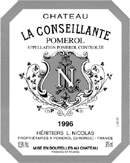
Owner: Nicolas family
Address: 33500 Pomerol
Telephone: 05 57 51 15 32; Telefax: 05 57 51 42 39
E-mail: chateau.la.conseillante@wanadoo.fr
Visits: By appointment only
Contact: Arnaud de Lamy
Surface area: 19.6 acres
Grape varietals: 80% Merlot, 20% Cabernet Franc
Average age of vines: 40+ years
Density of plantation: 5,500 vines per hectare
Average yields: 45 hectoliters per hectare
Elevage: Thirty day fermentation and maceration in temperature-controlled stainless-steel vats. After completion of malolactics, 18 months aging in new oak barrels. Fining, no filtration.
WINES PRODUCED
Château La Conseillante: 65,000 bottles
No second wine is produced.
Plateau of maturity: Within 5–20 years of the vintage
GENERAL APPRECIATION
One of the most characteristic Pomerols, La Conseillante is close in style to a grand cru Burgundy. This wine, which benefits from a sumptuous terroir that is not always fully exploited, can sometimes be exceptional. While some vintages lack concentration and structure, when La Conseillante hits the bull’s-eye, it remains unequaled in terms of aromatic power and elegance. It remains an expensive Pomerol.
A very highly regarded Pomerol estate, La Conseillante produces some of this appellation’s most elegant, lush, and delicious wines. On the negative side, many of the vintages during the 1970s had a tendency to turn out diluted, and they matured at an overly rapid rate. This was especially noticeable between 1971 and 1980. La Conseillante, owned by the Nicolas family, has been brilliant in most vintages of the 1980s, with the 1990, 1989, 1985, 1982, and 1981 among the finest wines produced in all of Bordeaux. The 1990s were again more erratic, giving further credibility to the estate’s inconsistent track record. The vineyard is superbly situated in eastern Pomerol next to L’Evangile, Petit Village, and Vieux Château Certan, right on the boundary of the St.-Emilion/Pomerol appellations. In fact, the deep, gravelly soils intermixed with clay and iron deposits in this area are common not only to La Conseillante and neighbor, L’Evangile, but also to the two great St.-Emilion estates across the road, Figeac and Cheval Blanc.
La Conseillante is a meticulously made wine. It is vinified in stainless-steel tanks and aged in oak barrels of which 100% are new each year. The wine is not as powerful in style as Pétrus, Trotanoy, Lafleur, or Certan de May, but it is always more supple and ready to drink sooner. Because La Conseillante never seems to show as well early on as it does after several years in the bottle, I have consistently underrated it, only to find myself revising my ratings upward. Perhaps it is the elevated percentage of Cabernet Franc (20%) that makes the wine look lighter in its infancy than it ultimately turns out to be. Recent vintages have, as a general rule, reached full maturity within 6–8 years. Being highly prized, as well as occasionally profound, La Conseillante is an expensive wine, normally selling at a price well above most Médoc second growths.
ANCIENT VINTAGES
The late 1970s were a period of considerable mediocrity, as were most of the 1970s, except for the 1975 (89 points; last tasted 9/02) and 1970 (93 points; last tasted 6/96). The 1970 is probably beginning to decline, while the 1975, with all of its tannic muscle, is probably capable of lasting another 5–10 years. Otherwise, the two vintages that many Pomerols did exquisitely well in, 1964 and 1961, are both good rather than superb efforts.
The truly museum pieces among La Conseillante’s portfolio (none of these have been retasted since the last edition of this book) are La Conseillante’s 1959 (95 points; last tasted 10/94), 1949 (97 points; last tasted 5/95), and 1947 (92 points; last tasted 12/95). These wines were fully mature when I had them, so unless they come from cold cellars where the wine has been impeccably stored for most of its life, I suspect these wines are largely over the hill.
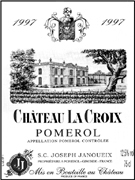
Owner: Joseph Janoueix family
Address: Catusseau, 33500 Pomerol
Mailing address: 37, rue Pline Parmentier, BP 192, 33506 Libourne Cedex
Telephone: 05 57 51 41 86; Telefax: 05 57 51 53 16
E-mail: info@j-janoueix-bordeaux.com
Website: www.j-janoueix-bordeaux.com
Visits: By appointment Monday to Friday, 8 A.M.–noon and 2–6 P.M. (5 P.M. on Fridays)
Contact: Ets Janoueix
Surface area: 24.7 acres
Grape varietals: 60% Merlot, 20% Cabernet Franc, 20% Cabernet Sauvignon
Average age of vines: 45 years
Density of plantation: 6,000 vines per hectare
Average yields: 45 hectoliters per hectare
Elevage: Twenty-five to twenty-seven day fermentation and maceration in temperature-controlled vats. Malolactics and 12–14 months aging in barrels with 80% new oak. Fining, no filtration.
WINES PRODUCED
Château La Croix: 42,000 bottles
Château Gabachot: 18,000 bottles
Plateau of maturity: Within 10–14 years of the vintage
GENERAL APPRECIATION
These are reliable, somewhat rustic, wines that rarely disappoint but are never inspiring.
La Croix, located on the outskirts of Libourne just off route D24, has a soil composition of gravel and sand. No wine made in this area ranks in the top dozen or so estates of Pomerol. Nevertheless, La Croix is a reputable property, producing big, dark-colored, tannic, full-bodied wines that can be criticized only for their lack of refinement and finesse. The best examples offer a mouth-filling, plump, rustic, simple pleasure that repays 6–12 years of cellaring. I have noticed in some vintages that a musty quality does intrude, suggesting that the cellar’s sanitary conditions could be improved. Fortunately, this happens infrequently. The château never receives a great deal of press, and given the fact that La Croix can turn out wines that are representative of the appellation, it remains a somewhat undervalued estate.
IMPORTANT VINTAGES
In the 25 years I have been tasting the wines of La Croix, nothing of significant interest has ever emerged. Certainly the wines were capable of hitting mid-80 point scores, but other than the occasional wine that I rated higher (the 1990, for example), this has been an underperforming estate in Pomerol.
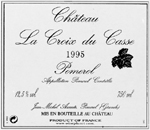
Owner: Societié Civile
Address: 33500 Pomerol
Mailing address: c/o Château Jonqueyres, 33750 Saint-Germain du Puch
Telephone: 05 57 34 51 66; Telefax: 05 56 30 11 45
E-mail: delphine.moussay-derouet@gamaudy.com
No visits
Surface area: 22.2 acres
Grape varietals: 70% Merlot, 30% Cabernet Franc
Average age of vines: 35 years
Density of plantation: 6,000 vines per hectare
Average yields: 48 hectoliters per hectare
Elevage: Fermentations and macerations can last up to six weeks in temperature-controlled stainless-steel vats. Completion of malolactics and 24 months aging in new oak barrels. No fining, no filtration.
WINES PRODUCED
Château La Croix du Casse: 48,000 bottles
Domaine du Casse: 7,200 bottles
Plateau of maturity: Within 4–10 years of the vintage
GENERAL APPRECIATION
A consistently good Pomerol since the late 1980s, La Croix du Casse is generally closed and tannic in its youth. In most cases, the fruit is so generous that this trait is not a problem. However, in certain vintages the tannins are rugged and coarse, so much so that the wine’s evolution may be compromised. While it is a soundly made wine, La Croix du Casse does not enjoy the reputation of its more famous siblings of the appellation.
The late Jean-Michel Arcaute, the manager who took Château Clinet from mediocrity to superstardom, passed away in a tragic drowning accident in 2001. His untimely death has left a void at this estate. Located south of the village of Catusseau, on a terrace of sandy and gravel-based soils, this tiny Pomerol estate is not as renowned or as well placed as many other Pomerols, but the quality can be a positive surprise. The entire vineyard had to be replanted following the catastrophic freeze of 1956.
IMPORTANT VINTAGES
2001 |
A sexy, opulent, flamboyantly styled Pomerol, this deep ruby/purple–colored 2001 exhibits medium to full body, low acidity, and a sumptuous style. Never pretending to be elegant, it offers loads of flesh, superripe fruit, and a juicy, succulent style. Enjoy it over the next 10–12 years. Last tasted, 1/03. |
2000 |
This wine displays some of the problems encountered in certain 2000s. Highly extracted, but extremely dry, austere tannins are ferocious as well as unrelenting. The wine exhibits impressive color saturation and plenty of black fruit, earthy, and spicy new oak characteristics, but the tannin level really is bothersome. Certainly this 2000 is concentrated, pure, and well made, but in the war between fruit and tannin, history usually favors the tannin. Anticipated maturity: 2008–2018? Last tasted, 1/03. |
1999 |
A potential sleeper, the opaque ruby/purple–colored 1999 displays superripe (sur-maturité as the French say) flavors of jammy black fruits intermixed with minerals, smoke, spice box, and new oak. Layered, with low acidity as well as a thick, expansive texture, this topflight Pomerol should evolve more quickly than the 1998, yet age well. Anticipated maturity: now–2015. Last tasted, 1/03. |
An outstanding effort, as well as one of the sleepers of the vintage, this dense ruby/purple–colored 1998 exhibits ripe, jammy notes of blackberries and cherries intermixed with licorice, smoke, and new wood. Full-bodied, with terrific fruit extraction, considerable muscle, and moderate tannin levels, it is not a wine to gulp down over the near-term. Anticipated maturity: 2005–2016. Last tasted, 3/02. |
|
1997 |
A sleeper of the vintage, this wine exhibits a dark plum color in addition to open-knit aromas of black cherries, plums, cedar, herbs, coffee, and vanilla. Round, delicious, and easy to understand and consume, this sexy, medium-bodied 1997 should drink well for 3–4 years. Last tasted, 3/01. |
1996 |
An impressive Pomerol, the 1996 possesses a saturated plum/purple color and a pure nose of spicy, sweet oak, minerals, black fruits, and prunes. The wine is surprisingly open-knit for a 1996, with an expansive, medium-to full-bodied, succulent texture. There is tannin in the finish, but it is nearly obscured by the wine’s glycerin, fruit extraction, and ripeness. Drink this attractive, silky Pomerol now and over the next 7–8 years. Last tasted, 3/01. |
1995 |
An outstanding wine, this dense ruby/purple–colored 1995 offers a knockout nose of blackberries, cassis, minerals, and spicy new oak. Medium to full-bodied, with plenty of toasty-like flavors and abundantly sweet fruit imbued with glycerin and tannin, this wine possesses a long mid-palate, as well as a finish that builds in the mouth. It is an impressively built, pure, rich Pomerol that merits considerable attention. Anticipated maturity: now–2015. Last tasted, 12/01. |
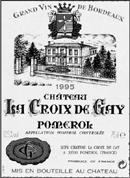
Owner: Raynaud and Lebreton families
Address: 33500 Pomerol
Telephone: 05 57 51 19 05; Telefax: 05 57 74 15 62
E-mail: contact@chateau-lacroixdegay.com
Website: www.chateau-lacroixdegay.com
Visits: Preferably by appointment Monday to Thursday and Saturday, 9 A.M.–1 P.M. and 2–5 P.M.; Friday, 2–5 P.M.
Contact: Chantal Lebreton
VINEYARDS
Surface area: 24.7 acres
Grape varietals: 90% Merlot, 5% Cabernet Franc, 5% Cabernet Sauvignon
Average age of vines: 30 years
Density of plantation: 5,000 vines per hectare
Average yields: 35 hectoliters per hectare
Elevage: Four week fermentation and maceration in temperature-controlled concrete tanks. Fifty percent of the yield undergoes malolactics in barrel. Eighteen months aging with 50% new oak and 50% one-year-old barrels.
WINES PRODUCED
Château La Croix de Gay: 40,000–45,000 bottles
No second wine is produced.
Plateau of maturity: Within 5–17 years of the vintage
La Croix de Gay is very good but never exceptional, probably because the finest parcels are culled out to produce their special cuvée, La Fleur de Gay. After a slump in the 1970s, the estate beautifully rebounded in the 1980s, producing very good wines. However, all in all, La Croix de Gay is a good to very good Pomerol that is worthy of interest, provided the prices are reasonable.
La Croix de Gay, one of the greatest discoveries of Englishman Harry Waugh in the late 1940s proved to be an inconsistent, even inadequate, performer in the 1970s and early 1980s. However, the proprietor, the handsome Dr. Raynaud, has increasingly upgraded the quality and now produces one of the most attractive and easy to drink Pomerols. In 1982 Dr. Raynaud launched his luxury cuvée of La Croix de Gay—called La Fleur de Gay—from a parcel of very old vines of Merlot planted between Pétrus and Lafleur. This luxury cuvée of old vines (profiled separately, see here) is very rare in Bordeaux, but it is one of the most magnificent wines of the appellation, rivaling the finest Pomerols in complexity and intensity. Some skeptics have argued that Dr. Raynaud’s decision to make a special cuvée robs the primary wine, La Croix de Gay, of its best source of richness and backbone. But despite the addition of a luxury cuvée, one cannot ignore the fact that La Croix de Gay has improved immensely. His sister, Chantal Lebreton, assumed control of the estate in the mid-1990s.
The vineyards of La Croix de Gay sit at the very northern section of Pomerol’s plateau, immediately behind a cemetery and the tiny road called D245 that traverses the appellation. The soil in this area is gravel intermixed with sand.
IMPORTANT VINTAGES
ANCIENT VINTAGES
This is not a wine, except in the very greatest vintages, to push past 10–15 years of cellaring. My top notes are from 1989 (87 points; last tasted 3/97), 1982 (rated 82; last tasted 3/97), 1964 (90 points; last tasted, 3/90), and 1947 (92 points; last tasted 10/99). To date, the 1964 and 1947 look to be the finest wines made at La Croix de Gay, but for readers looking for a soft, very agreeable, accessible style of Pomerol, this wine certainly has merit.
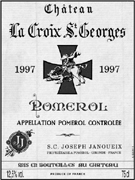
Owner: Joseph Janoueix family
Administrator: Jean-Philippe Janoueix
Address: 33500 Pomerol
Mailing address: 83, cours des Girondins, 33500 Libourne
Telephone: 05 57 25 91 19; Telefax: 05 57 48 00 04
Visits: By appointment only
Contact: Jean-Philippe Janoueix
VINEYARDS
Surface area: 11.1 acres
Grape varietals: 100% Merlot
Average age of vines: 35 years
Density of plantation: 6,500 vines per hectare
Average yields: 35 hectoliters per hectare
Elevage: Four to six week fermentation and maceration in temperature-controlled open-top wooden fermenters of 60 hectoliter capacity, with manual pigéage. Malolactics and 18 months aging in normal barrels for half the yield and in cigar-shaped barrels for the other half. No fining or filtration.
Château La Croix St.-Georges: 15,000 bottles
Le Prieuré: 5,000–7,000 bottles
Plateau of maturity: Within 5–20 years of the vintage
GENERAL APPRECIATION
Jean-Philippe Janoueix’s aim is to propel La Croix St.-Georges amongst the first five best Pomerols.
This 11.1 acre vineyard owned by the Janoueix family (of De Chambrun fame) and situated among some of the stars of Pomerol (i.e., Vieux Château Certan) burst on the scene with a blockbuster 1999, which has been followed by an equally impressive 2000 and 2001. This super-cuvée of 100% Merlot is another garage wine that receives all the fashionable winemaking treatments that are now the rage in Pomerol and St.-Emilion (i.e., fermentation in open-top wood cuves, punching down of the must, malolactic in barrel, extensive lees contact, and bottling without fining or filtration). Sadly, the quantities produced are small and the wine is nearly impossible to find.
IMPORTANT VINTAGES
2001 |
The impressive 2001 is produced from yields of 39 hectoliters per hectare. It sports a dense purple color as well as a sweet, expansive perfume of black cherry liqueur, blackberries, licorice, and toasty oak, full body, and layers of glycerin as well as sweet tannin. If the 2001 behaves like the 2000 (which gained weight and texture with aging), it will merit a score in the low 90s. Anticipated maturity: 2005–2017. Last tasted, 1/03. |
2000 |
The 2000 has put on considerable weight. I would never have guessed it would become this rich, concentrated, or compelling. An incredibly sweet perfume of blackberry liqueur, kirsch, cassis, new saddle leather, truffles, toasty oak, and smoke soars from the glass of this full-bodied, massively concentrated effort with an extraordinary finish. Anticipated maturity: 2007–2020+. Last tasted, 1/03. |
1999 |
The 1999 La Croix St.-Georges is even better than I anticipated. It is an amazingly opaque purple–colored wine with extraordinary fat and richness, concentrated, jammy blackberry and cherry fruit, and liqueur-like intensity. Multilayered, extremely generous, and sumptuous on the palate, with a remarkable finish, it is a star of the vintage. Wow! Anticipated maturity: 2004–2020. Last tasted, 3/02. |
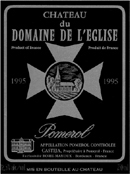
Owner: Indivision Castéja
Address: 33500 Pomerol
Mailing address: 86, cours Balguerie Stuttenberg, 33082 Bordeaux
Telephone: 05 56 00 00 70; Telefax: 05 57 87 48 61
E-mail: domaine.boriemanoux@dial.oleane.com
Visits: By appointment only
Contact: Mrs. Marquasuzaa (05 56 00 00 97)
Surface area: 17.3 acres
Grape varietals: 95% Merlot, 5% Cabernet Franc
Average age of vines: 40 years
Density of plantation: 7,200 vines per hectare
Average yields: 38 hectoliters per hectare
Elevage: Three to five week fermentation and maceration in temperature-controlled stainless-steel tanks. Sixteen to eighteen months aging in barrels with 60% new oak. Fining, no filtration.
WINES PRODUCED
Domaine de L’Eglise: 30,000 bottles
Plateau of maturity: Within 4–12 years of the vintage
GENERAL APPRECIATION
Long an uninspiring Pomerol (be cautious when dealing with vintages prior to 1990), Domaine de L’Eglise has improved significantly since the 1990s. While it is not one of the most opulent and richest wines of the appellation, it is unquestionably seductive, exhibiting a pleasant, soft fruitiness and some elegance. I believe this wine could be significantly better if the potential of its terroir were fully exploited. Proprietor Philippe Castéja continues to make improvements at this property (especially noticeable since 1995).
This beautifully situated vineyard is adjacent to the cemetery of Pomerol on the high plateau and has a gravelly soil intermixed with some sand. The château and vineyard are believed to be the oldest of Pomerol. The property was run as a winemaking estate by the Hospitaliers de Saint-Jean de Jerusalem who managed a hospital known as Domaine Porte Rouge in Pomerol for lepers long before the French Revolution. As with many church-run properties, the revolution resulted in divestiture and placement in private hands, where it has remained. It was acquired by the négociant firm of Borie-Manoux in 1973.
Solid and reliable wines were made in the 1970s and early 1980s but since the late 1980s the quality has increased. Domaine de L’Eglise was particularly damaged during the 1956 freeze, and the vineyard was totally replanted. The lighter, more commercial style of wines produced in the 1970s and 1980s as well as the 1990s gave way in the late 1980s to a richer, more profound and compelling product.
IMPORTANT VINTAGES
2001 |
Even though it revealed an impressively saturated black/ruby/purple color, this wine lacked acidity and came across as monolithic, although there is plenty of depth, ripeness, and richness. In the past, wines such as this have tended to become more delineated and reveal more grip after some extra barrel aging. If that happens, this Pomerol will easily merit a score in the high 80s. There is plenty going on in this pure, concentrated effort. Anticipated maturity: 2006–2015. Last tasted, 1/03. |
This should turn out to be the finest wine from Domaine de L’Eglise in many years. It possesses the brutal tannin found in top Pomerols from the plateau sector, but also an opaque purple color, high levels of extract, medium to full body, and superb purity. It is a rich, impressive vin de garde to drink between 2008–2020. Last tasted, 1/03. |
|
1999 |
Deep ruby/purple–colored and medium to full-bodied, with notes of new oak and chocolate-covered truffles, this toasty, low-acid, plump, approachable wine should be drunk over the next 10 years. Last tasted, 3/02. |
1998 |
A soft, plump, forward, deep ruby–colored Pomerol, the 1998 offers abundant quantities of toffee, black cherry, mocha, chocolaty, and toasty new oak aromas as well as flavors. Drink this medium-bodied, user-friendly wine over the next eight years. Last tasted, 3/02. |
1997 |
Intriguing roasted coffee, berry, chocolate, and toast aromas emerge from this medium dark–ruby colored wine. Round, plump, and succulent, with moderately good concentration, this is a cleanly made, competent Pomerol to drink over the next two years. Last tasted, 3/01. |
1995 |
An impressive saturated black/purple color is followed by a wine with excellent black cherry and cassis fruit, medium body, fine purity, and surprising opulence and unctuosity. Anticipated maturity: now–2016. Last tasted, 11/97. |
1994 |
Dark ruby–colored, with attractive, jammy, cherry, earth, and spicy scents, this mid-weight, ripe 1994 displays no hard edges or vegetal notes, but lacks stuffing and length. It should drink well for 2–3 years. Last tasted, 3/99. |
ANCIENT VINTAGES
The best vintage I have tasted over the last 25 years was the 1989 (89 points; last tasted 3/98). The wine is still showing considerable power, richness, and a far denser color and more extracted flavors than most other vintages. A hint of prune was the only negative in an otherwise impressive performance. The wine exhibits a nose of sweet black cherries, plums, and earth. It reached maturity relatively quickly and needs to be drunk over the next 6–7 years.
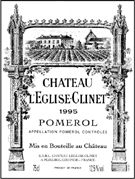
Owner: GFA du Château L’Eglise-Clinet
Address: 33500 Pomerol
Telephone: 05 57 25 90 00; Telefax: 05 57 25 21 96
E-mail: eglise@denis-durantou.com
Website: www.eglise-clinet.com
Visits: By appointment only
Contact: Denis Durantou
VINEYARDS
Surface area: 14.8 acres
Grape varietals: 85% Merlot, 15% Cabernet Franc
Average age of vines: 45 years
Density of plantation: 6,500 vines per hectare
Average yields: 35 hectoliters per hectare
Elevage: Fifteen to twenty-one day fermentation and maceration in small temperature-controlled stainless-steel tanks of 30 to 50 hectoliter capacity. Fifteen to eighteen months aging with 40–70% new oak. Fining, no filtration.
WINES PRODUCED
Château L’Eglise-Clinet: 12,000–15,000 bottles
La Petite L’Eglise: 15,000–20,000 bottles
Plateau of maturity: Within 10–30 years of the vintage
GENERAL APPRECIATION
While it is one of the least known wines of the appellation because of its tiny production, L’Eglise-Clinet has always ranked among the finest Pomerols and is generally richly fruity, generous, and fat. In terms of quality, it is on par with today’s new stars such as Clos l’Église, L’Evangile, or La Conseillante. L’Eglise-Clinet is still very much of an insider’s secret, but it has a fiercely loyal following, so latching on to a few bottles of this beauty is difficult. Its quality and rarity account for the high price it fetches—but the wine is worth it. A must buy.
One of the least known Pomerol estates, L’Eglise-Clinet often produces a typically fat, succulent, juicy, richly fruity style of Pomerol. The wine is well/known and admirably and traditionally made, but because of the tiny production, it is rarely tasted. The vineyard is well situated on the plateau of Pomerol behind the church where the soils are deep gravel beds intermingled with sand, clay, and iron.
L’Eglise-Clinet is one of the few Pomerol vineyards not replanted after the 1956 killing freeze (nor was there any vine damage in the frosts of 1985 and 1987), and consequently it has very old vines, a few of which exceed 100 years in age.
Until 1983, Pierre Lasserre, the owner of the bigger and better-known Pomerol property of Clos René, farmed this vineyard under the métayage system (a type of vineyard rental agreement) and turned out a wine that was rich, well balanced, supple, firm, and always well vinified. Since then, the winery has been run by the young, extremely dedicated Denis Durantou, who is trying to take this tiny vineyard to the very top of the unofficial Pomerol hierarchy. The secret here is not only Durantou’s remarkable commitment to quality, but vines that average 40–45 years in age, plus the fact that in abundant and/or difficult vintages one-fourth of the crop is relegated to the second wine called La Petite L’Eglise. One cannot applaud the efforts of Denis Durantou enough.
The price for a bottle of L’Eglise-Clinet is high, as connoisseurs recognize that this is one of the top dozen wines of the appellation.
IMPORTANT VINTAGES
ANCIENT VINTAGES
L’Eglise-Clinet, like most châteaux, has an erratic record, but the peaks seem to confirm what a great terroir this property possesses. Some of my favorite vintages are as follows: 1975 (92? points; last tasted 11/02) is a hugely concentrated, still very young wine that is somewhat similar, with its astringent tannin, to the 1982. It is a massive wine, still youthful, but also shows immense potential along with the possibility that it still needs another 8–10 years. No question this wine will evolve through the first three decades of the 21st century, but will it ever attain perfect harmony? Fully mature and now starting to fade, the 1971 (92 points; last tasted 12/95) is certainly one of the three best Pomerols of the vintage (Trotanoy and Pétrus being the other two). Anyone who owns it should not push their luck any further. The 1961 (92 points; last tasted 9/95) was a fabulous example of that vintage, showing a huge nose of soy sauce, grilled meats, mocha chocolate, and black cherry fruit, with full body and opulent texture. Even better was the 1959 L’Eglise-Clinet (96 points; last tasted 10/95) with an absolutely amazing nose of kirsch intermixed with Asian spices, Häagan-Dazs Jamocha Chocolate Chip ice cream, and caramel. It is unctuously textured, very viscous, and certainly one of the most concentrated and layered examples from L’Eglise-Clinet in the last 40 years.
Several masterpieces should be noted. The 1950 (95 points; last tasted 9/95), from a great vintage in Pomerol, was phenomenal. The virtually perfect 1949 (99 points; last tasted 9/95) is another masterpiece, and the 1947 (100 points; last tasted 9/95), 1945 (98 points; last tasted 9/95), and 1921 (100 points; last tasted 9/95) are all extraordinary wines that were tasted from pristinely stored bottles and, in several cases, magnums. They are the kind of wines that would certainly give L’Eglise-Clinet the ability to argue that when it hits all cylinders, it is every bit as profound a Pomerol as Pétrus.
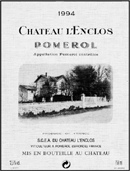
Owner: GFA du Château L’Enclos
Address: lieu-dit L’Enclos, 20, rue du Grand Moulinet, 33500 Pomerol
Telephone: 05 57 51 04 62; Telefax: 05 57 51 43 15
E-mail: chateaulenclos@wanadoo.fr
Website: www.chateau-lenclos.com
Visits: By appointment Monday to Friday
Contact: Hugues Weydert
VINEYARDS
Surface area: 23.3 acres
Grape varietals: 82% Merlo, 17% Cabernet Franc, 1% Pressac
Average age of vines: 31 years
Density of plantation: 6,000 vines per hectare
Average yields: 45 hectoliters per hectare
Elevage: Three to four week fermentation (28–32°C) and maceration (22–24°C) in temperature-controlled stainless-steel vats with 2–4 daily pumpings-over. Twelve to fourteen months aging in barrels with 40% new oak. Fining, light filtration upon bottling.
WINES PRODUCED
Château L’Enclos: 52,000 bottles
No second wine is produced.
Plateau of maturity: Within 3–15 years of the vintage
GENERAL APPRECIATION
This discrete, low-key estate produces elegant wines that fully reveal themselves after 4–5 years of age. In the best vintages, L’Enclos can be very good to excellent. Over recent years, it has not performed to the level it had attained in the 1980s, but I hope this is temporary, as L’Enclos represents a good buy.
Located on sandy, gravelly, and flinty soil in the most western portion of the Pomerol appellation, L’Enclos is an unheralded property that can produce fine wine. The finest vintages offer consistently smooth, velvety, rich, supple, nicely concentrated, pure blackberry fruitiness and overall harmony. In most vintages L’Enclos only needs 3–4 years of bottle age to reveal the opulent, rich, silky fruitiness, yet the wines hold up well in the bottle.
IMPORTANT VINTAGES
2001 |
A soft, creamy-textured wine with sweet caramel-infused berry and cherry fruit, this medium-bodied Pomerol needs to be drunk over the next 5–10 years. Anticipated maturity: now–2011. Last tasted, 1/03. |
The 2000 is light and lacking in both density and concentration. Notes of caramel, mocha, and cherries are present in this medium-bodied, soft Pomerol. It requires consumption during its first 5–6 years of life. Last tasted, 1/03. |
ANCIENT VINTAGES
L’Enclos’s performance in the 1990s was mediocre, with most of my scores ranging from the low to high 70s, with the 1995 vintage rated 86 points (last tasted 3/99). The only other exception was the delicious 1990 (88 points; last tasted 11/01). In the 1980s, the track record was erratic but more consistent, with the 1989 rated 87 (last tasted 3/96) and the 1982 rated 88 (last tasted 11/02). Of the two stars of the vintage, only the 1982 seems capable of lasting another 5–10 years, and certainly gets my nod as the best L’Enclos of the last 25 years. Another vintage to keep an eye out for, although I expect it is in decline now is the 1975 (89 points; last tasted 1/85). The vintage certainly has stood the test of time but remains very controversial.
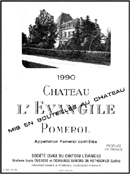
Owner: Domaines Barons de Rothschild (Lafite)
Address: 33500 Pomerol
Telephone: 05 57 55 45 55; Telefax: 05 57 55 45 56
E-mail: evangile@wanadoo.fr
Website: www.lafite.com
Visits: By appointment only
Contact: Jean-Paul Vazart
VINEYARDS
Surface area: 34.6 acres
Grape varietals: 75% Merlot, 25% Cabernet Franc
Average age of vines: 40 years
Density of plantation: 6,000 vines per hectare
Average yields: 40 hectoliters per hectare
Elevage: Twenty-five to thirty day fermentation and maceration in temperature-controlled stainless-steel and concrete tanks. After completion of malolactics in vats, 18 months aging in barrels with 80% new oak. Fining and filtration if necessary.
WINES PRODUCED
Château L’Evangile: 3,500–4,000 cases
Blason de L’Evangile: 1,000–1,500 cases
Plateau of maturity: Within 6–30 years of the vintage
GENERAL APPRECIATION
While L’Evangile has always been a star of its appellation, it managed to improve over recent years under the ownership of the Rothschilds (of Lafite) and qualitatively rivals Pétrus and Lafleur. This exceptional wine magnificently translates its terroir through its sumptuous richness and opulence. Always distinctive, it is one of the longer lived Pomerols. The only criticism I would express concerns the fining and filtration, which in certain vintages has robbed the wine of that extra-richness. Unfortunately, prices have followed the curve of quality—but the wine is worth it.
Anyone who has tasted the 2001, 2000, 1998, 1995, 1990, 1989, 1985, 1982, 1975, 1961, 1950, and 1947 L’Evangile knows full well that this property can make wines of majestic richness and compelling character. Bordered on the north by the Who’s Who of vineyards, La Conseillante, Vieux Château Certan, and Pétrus, and on the south by the great St.-Emilion Cheval Blanc, the 34.6-acre vineyard is brilliantly situated on deep, gravelly soil mixed with both clay and sand. With these advantages, I believe that L’Evangile (never a model of consistency) can produce wines that rival Pétrus, Lafleur, and Cheval Blanc.
That is now happening. In 1990 the Rothschild family (of Lafite Rothschild) purchased a controlling interest. In 2000 they became 100% owners along with Albert Frère (a wealthy Belgian who also has an interest in Cheval Blanc). They are fully aware of the unlimited potential of this estate, and L’Evangile may soon be challenging Pétrus and Lafleur in both quality and, lamentably, price.
Certainly the late Louis Ducasse must have realized the distinctiveness of his vineyard because he often browbeat visiting wine critics with his observation that L’Evangile was as good as, and even more complex than, neighboring Pétrus. The remarkable Madame Ducasse died several years ago while in her mid-90s and still running L’Evangile on a day-to-day basis. I remember having lunch with this amazing woman in the early 1990s, where she poured the 1964, 1961, and 1947 from her personal cellar. At the end of a sumptuous lunch of gigantic portions of truffles, ris de veau, and filet de boeuf, I remarked that the only person who had eaten everything, and who had finished each glass of glorious wine even more quickly than the guests, was Madame Ducasse!
Now that L’Evangile is completely under Rothschild ownership, I fully anticipate this property will challenge Pétrus as well as Cheval Blanc year in and year out. It is a magical vineyard, as evidenced by the great wines that have been produced in years where there was no selection and a somewhat seat-of-the-pants vinification and upbringing of the wine. That will all change under the perfectionist regime of the Rothschilds. This is a Pomerol with a great track record already that looks poised to attain even greater heights . . . and prices.
IMPORTANT VINTAGES
ANCIENT VINTAGES
In the 1970s, the undeniable success was the 1975 (98 points; last tasted 8/02). It is a fabulous wine, fully mature, with more evolved aromas than the 1982 but not terribly dissimilar from that forceful, very powerful, highly extracted wine. It seems capable of lasting at least another 15–20 years, and it is one of the great classics of this controversial vintage. Other vintages of the 1970s have proven to be relatively disappointing, as have most of the vintage of the 1960s, with ratings from the low 70s to mid-80s on my score card. Pristine bottles of the 1961, however, proved the exception (99 points; last tasted 3/94). This is a wine where 66% of the blend came from three-year-old vines. This is a wine of extraordinary Port-like richness and even more viscosity and concentration than the 1982. Another great wine is the 1947 (rated 100 when tasted 3/97 and rated 97 when tasted 12/95). Another ancient vintage to look for is the 1950 (90 points; last tasted 3/00). It is fully mature and faded quickly in the glass, but the first 20 minutes were gorgeous.
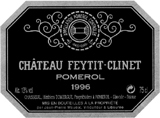
Owner: Chasseuil family
Address: 33500 Pomerol
Telephone: 05 57 25 51 27 or 06 85 52 33 18; Telefax: 05 57 25 93 97
Visits: By appointment only
Contact: Jérémy Chasseuil
VINEYARDS
Surface area: 17.3 acres
Grape varietals: 90% Merlot, 10% Cabernet Franc
Average age of vines: 25 years
Density of plantation: 6,900 vines per hectare
Average yields: 40 hectoliters per hectare
Elevage: Four to five week fermentation and maceration in temperature-controlled concrete vats. Wines undergo malolactics in barrels. Sixteen to eighteen months aging in barrels with 70% new oak. No fining, no filtration.
WINES PRODUCED
Château Feytit-Clinet: 20,000–25,000 bottles
(name not yet defined): 8,000 bottles
Plateau of maturity: Within 5–12 years of the vintage
Long in the throes of mediocrity, Feytit-Clinet has spectacularly improved during the last 3–4 years, with vintages from 1998 onward being close to excellent. Obviously, there is still room for improvement, but the quality level is far higher than it used to be. The good news is that the renaissance of Feytit-Clinet is still much of an insider’s secret, so shrewd consumers should be on the lookout for the coming vintages, especially as prices remain reasonable.
This 17.3-acre vineyard planted with 90% Merlot and 10% Cabernet Franc is situated near Trotanoy and Latour à Pomerol. For a long time one of Pomerol’s underachievers, it has immensely improved over the last three or four vintages. The estate, which had been farmed for a number of years by the Libourne-based firm of Jean-Pierre Moueix, is now managed by its owners, the Chasseuil family. Yields were reduced significantly, and a second wine was introduced. Quality has improved dramatically since Feytit-Clinet escaped Moueix control, making one wonder what was going on during their period of occupancy of this vineyard.
IMPORTANT VINTAGES
2001 |
The 2001 Feytit-Clinet is the finest wine I have tasted from this estate. Production was 2,000 cases from yields of 40 hectoliters per hectare. An impressive ruby/purple color is followed by sweet aromas of black fruits and licorice (or is it truffles?). With admirable texture, low acidity, excellent to outstanding ripeness, as well as concentration and medium to full body, it will be at its apogee between 2005–2015. Last tasted, 1/03. |
2000 |
A solid as well as substantial wine, this dark ruby, medium-bodied Pomerol offers a bouquet of melted licorice, black cherries, and earth. Good power, ripe tannin, and a chunky, somewhat monolithic style suggest aging/cellaring is warranted. Anticipated maturity: 2007–2014. Last tasted, 1/03. |
1998 |
Dark purple–colored with a deep, intense, extracted feel, the 1998 is a moderately closed, yet promising, medium- to full-bodied wine with excellent richness and earthy, licorice, and black cherry/cranberry-like fruit flavors. There is plenty of glycerin, moderately high tannin, and a mouth-filling personality to this large-scaled effort. Anticipated maturity: now–2016. Last tasted, 3/02. |
ANCIENT VINTAGES
If truth be told, there is virtually nothing of interest I have ever tasted in the 1970s, 1980s, and early 1990s from Feytit-Clinet that I would want to own in my cellar or would want anyone reading this book to purchase. Several vintages, like the 1990, were pleasant but, by and large, this was a diluted, thin, often herbaceous wine that turned out uninspiring year in and year out.

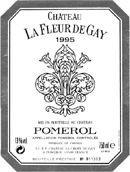
Owner: Raynaud and Lebreton families
Address: 33500 Pomerol
Telephone: 05 57 51 19 05; Telefax: 05 57 74 15 62
E-mail: contact@chateau-lafleurdegay.com
Website: www.chateau-lafleurdegay.com
Visits: Preferably by appointment Monday to Thursday and Saturday, 9 A.M.–1 P.M. and 2–5 P.M.; Friday, 2–5 P.M.
Contact: Chantal Lebreton
VINEYARDS
Surface area: 7.4 acres
Grape varietals: 100% Merlot
Average age of vines: 45 years
Density of plantation: 5,000 vines per hectare
Average yields: 20 hectoliters per hectare
Elevage: Cold maceration, three to four week fermentation and maceration in temperature-controlled concrete tanks. Wines undergo malolactics and are aged in 100% new oak for 18 months. No fining, no filtration.
WINES PRODUCED
Château La Fleur de Gay: 6,000–9,000 bottles
Plateau of maturity: Within 5–20 years of the vintage
GENERAL APPRECIATION
This wine, the special cuvée from La Croix de Gay, can be one of the most exciting Pomerols in the best vintages, as evidenced by the 1990 and 1989. After a difficult period at the beginning of the 1990s, the estate seems to have rebounded beautifully and has come back to its former quality level. Among the top-notch Pomerols, La Fleur de Gay remains a reasonably good buy. However, limited availability makes it difficult to find.
La Fleur de Gay, the luxury cuvée of La Croix de Gay, was launched by Dr. Alain Raynaud in 1982 (see here). The wine comes from a small parcel of very old vines situated between Pétrus and Vieux-Château-Certain that is part of Dr. Raynaud’s better-known estate called La Croix de Gay. Aged in 100% new oak, it is a wine that is characterized by a compelling opulence and sweetness, as well as exceptional purity of fruit. Michel Rolland oversees the vinification and upbringing of this luxuriously flavored, intense, full-bodied wine. Vintages to date give every indication of possessing 10–20 years of aging potential. The secret . . . low yields and a ripe harvest. The 7.4 acre, 100% Merlot vineyard situated in the heart of the Pomerol plateau keeps yields of approximately 25 hectoliters per hectare. Malolactic fermentation takes place in barrel, and the wine is bottled without fining or filtration.
ANCIENT VINTAGES
The debut vintage for La Fleur de Gay, 1982, was a disappointment, and when last tasted (3/02; 75 points) it was in decline and completely diffuse and unattractive. The 1983 (rated 87?; last tasted 3/02) is also starting to crack up and needs to be drunk now. Herbaceous notes mixed with compost, Chinese black tea, and red currant fruit notes are still there, but the tannins have become more noticeable, giving the wine a desiccated feel in the mouth.
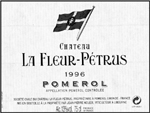
Owner: SC Château La Fleur-Pétrus
Address: 33500 Pomerol
Mailing address: c/o Ets Jean-Pierre Moueix, BP 129, 54, quai du Priourat, 33502 Libourne Cedex
Telephone: 05 57 51 78 96; Telefax: 05 57 51 79 79
Visits: By appointment and exclusively for professionals of the wine trade dealing with the firm
Contact: Frédéric Lospied
VINEYARDS
Surface area: 33.2 acres
Grape varietals: 85% Merlot, 15% Cabernet Franc
Average age of vines: 35 years
Density of plantation: 6,250 vines per hectare
Average yields: 39 hectoliters per hectare
Elevage: Twenty to twenty-four day fermentation and maceration in temperature-controlled concrete vats. Twenty months aging in barrels that are renewed by a third at each vintage. Fining, no filtration.
WINES PRODUCED
Château La Fleur-Pétrus: 50,000 bottles
Plateau of maturity: Within 5–15 years of the vintage
GENERAL APPRECIATION
While this wine has always enjoyed a fine reputation, its performance from the end of the 1960s through the mid-1990s was not exceptional. However, in 1995 the wines began to improve.
Located on the eastern side of the plateau of Pomerol between Lafleur and Pétrus (hence the name) where so many of the best estates are found, La Fleur-Pétrus should be one of the most exquisite Pomerols. The famous firm of Jean-Pierre Moueix purchased the estate in 1952, and the vineyard was entirely replanted after 1956, when it was virtually destroyed by the apocalyptic winter freeze. The wine at La Fleur-Pétrus is lighter in weight and texture than other Mouiex Pomerols, such as Pétrus, Trotanoy, and Latour à Pomerol, but connoisseurs prize it for elegance and a supple, smooth, silky texture. It usually matures quickly and can be drunk as soon as five or six years after the vintage. Recent vintages have produced very fine wines, but I cannot help thinking that the quality could and should be higher. This appears to be happening. Readers should recognize that Christian Moueix is trying to push this estate’s quality level to greater heights. To this end, he has acquired the finest section of old vines from Château Le Gay, and has instituted a more rigorous selection in both the vineyard and cellars. The winery itself has also been renovated. Some of La Fleur-Pétrus’s finest wines have been produced only since 1998.
IMPORTANT VINTAGES
2001 |
The dark ruby/purple colored 2001 has added weight and richness. Deep, dense, muscular, and rich, this traditionally vinified wine is not meant to be flattering young. A wine of excellent purity, it possesses noticeably sweet black cherry, and currant fruit intermixed with subtle wood and damp foresty aromas. Medium bodied, elegant, well delineated, and more powerful than I thought, it will be drinkable between 2010–2022. Last tasted, 1/03. |
2000 |
A revelation in my bottle tastings was the fabulous performance of La Fleur-Pétrus’s 2000. This is a wine of great concentration with a fabulous dense purple color, powerful, long, highly extracted flavors, and copious sweet tannin in the finish. Unlike many 2000 Pomerols, the tannin is well integrated and sweet, but it shares its neighbor’s large size as well as impressive concentration and power. If it continues to perform in this manner, it will eclipse the great 1998. However, it will not be as accessible young. A modern-day bigger and better 1975? Anticipated maturity: 2007–2025. Last tasted, 1/03. |
Performing well, with more power and depth after bottling than before, this wine exhibits a dense ruby color as well as a sweet nose of pure black cherry jam intermixed with hints of raspberry, new wood, and earth. Surprisingly powerful for a 1999, with admirable ripeness, sweet tannin, and low acidity, it will be at its peak between 2004 and 2015. Last tasted, 3/02. |
|
1998 |
Along with the 2000, this is the finest La Fleur-Pétrus I have tasted. This dense ruby/purple–colored wine exhibits aromas and flavors of Chinese black tea, raspberries, kirsch and flowers. Elegant, yet crammed with concentrated fruit, it is symmetrical, harmonious, and long, with tremendous persistence on the palate. While not a blockbuster/heavyweight, it is a wine of finesse and richness that admirably balances power with elegance. A great success! Anticipated maturity: now–2020. Last tasted, 3/02. |
1997 |
This 1997 is sexy, opulently textured, full-flavored, with low acidity as well as delicious, up-front appeal. Lavish cherry fruit intermixed with mocha, dried herbs, spice box, and toasty oak are present in this medium-to full-bodied, fruit-driven wine. Already evolved, complex, and tasty, it will age well for 7–8 years. Last tasted, 3/02. |
1996 |
The 1996 boasts an impressively saturated ruby/purple color, as well as a pure, sweet nose of cherries, plum liqueur, spicy oak, and floral scents. The wine possesses excellent depth, medium body, superb purity, and an overall elegant personality offering a combination of power and finesse. Anticipated maturity: now–2015. Last tasted, 3/01. |
1995 |
A saturated dark purple color suggests a wine of considerable depth and concentration. The nose offers up gorgeous aromas of sweet kirsch intermixed with black raspberry, mineral, and smoky notes. Full-bodied, with superb richness and purity, loads of tannin, and a layered, multidimensional personality, this terrific La Fleur-Pétrus is one of the three finest wines I have tasted at this property in the 20 years I have been visiting Bordeaux. It is a splendid effort! Anticipated maturity: 2007–2025. Last tasted, 10/02. |
1994 |
The attractive kirsch, cherry, toasty nose is followed by a medium-bodied, restrained, pure, measured wine. The 1994 offers an impressively saturated color, as well as an inner core of sweet, concentrated fruit and moderate tannin in the finish. All the richness, extract, and balance are present in this impressively endowed wine that should be drunk between now and 2018. Last tasted, 10/02. |
1990 |
Fully mature, with a very complex nose of roasted coffee, mocha, cedar, and Provençal herbs, all backed up by some sweet cherry fruit, this medium-bodied, relatively elegant, soft, very accessible wine is already showing considerable amber to its garnet color. The finish also begins to fall off a bit, but the complexity and delicious attack make for a very satisfying drink. Anticipated maturity: now–2006. Last tasted, 3/02. |
1989 |
In the ongoing competition between the 1990 and 1989 vintages, in the case of La Fleur-Pétrus, the 1989 comes out a clear winner. The dense plum/garnet color offers up notes of underbrush, dried herbs, caramel, sweet cedar, and jammy black cherries intermixed with some balsam wood. In the mouth the wine is deep, very pure, ripe, with moderate tannins still to be shed. A very impressive, gorgeous La Fleur-Pétrus that is the best wine made during a somewhat indifferent period for this property. Anticipated maturity: 2004–2015. Last tasted, 3/02. |
1988 |
Very vegetal on the nose and becoming more cedary as the wine sits in the glass, the flavors are dusty, with gritty tannin and almost desiccated red currant fruit notes. The wine seems to be drying out and in decline. Anticipated maturity: Drink up. Last tasted, 3/02. |
A very simple, one-dimensional La Fleur-Pétrus that is holding on to life but showing very little depth or concentration. The nose is somewhat muted, but does offer up some dusty, earthy, loamy soil scents intermixed with the smell of underripe tomatoes and Provençal herbs. In the mouth, the wine is attenuated, compact, medium bodied, and lacking concentration. Anticipated maturity: now–2010. Last tasted, 3/02. |
|
1985 |
This wine merits attention largely because of the very complex aromatics that consist of menthol, tomato skin, cedar, smoke, sweet cherries, and plums. In the mouth, the attack is impressive, medium bodied, elegant, soft, and pure, and the finish is all velvet, but there is not much intensity or follow-through. The wine is also fully mature, as evidenced by the considerable amber creeping at the color’s rim. Anticipated maturity: Drink up. Last tasted, 3/02. |
1983 |
Drying out, becoming desiccated, with the herbaceous element taking over what little fruit is left, this wine was fully mature 5–8 years after the vintage and is now in complete decline. Anticipated maturity: Drink up. Last tasted, 3/02. |
1982 |
Very inconsistent in more than a dozen tastings, this wine has never fully lived up to the expectations I had for it prior to bottling. This was a period when Christian Moueix and his conservative oenologist Jean-Claude Berrouet were, in my opinion, doing entirely too much fining and filtration, often killing much of the texture and flavor in too many wines that tasted great out of cask. Obviously things changed, but we still have great vintages like this that are perplexing and not what they should be. The wine still shows a nice plum, mulberry, herbaceous, coffee-scented nose with some cedar and spice box. In the mouth, it is medium bodied with surprising acidity and moderate tannin. The finish is a bit short. After tasting through much of a case, and never seeing the wine live up to my expectations, I am convinced now this wine is in decline, somewhat unusual for a well-stored 1982. Anticipated maturity: Drink up. Last tasted, 11/02. |
ANCIENT VINTAGES
A bevy of mediocrities exist except for the 1975 (90 points; last tasted 3/02), 1971 (90 points; last tasted 12/01), 1970 (88 points; last tasted 3/02), and the fabulous 1961 (92 points; last tasted 12/95). Of those vintages, the only one I would still gamble with would be the 1975, as it seemed to have the extract and tannic structure to continue to drink well through 2015 or so.
Among the museum pieces in the La Fleur-Pétrus portfolio, the 1952 (91 points, last tasted 3/89), 1950 (95 points; last tasted 3/89), and 1947 (90 points; last tasted 12/95) are wines I have not tasted since the last edition of this book, but I assume they are largely in decline, although well-stored bottles of the 1950 and 1947 would certainly be worth the gamble and would probably be less expensive than other great wines from those two vintages.
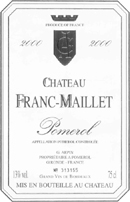
Owner: Gérard Arpin
Address: Maillet, 33500 Pomerol
Telephone: 09 09 73 69 47; Telefax: 05 57 51 96 75
E-mail: vignobles-g-arpin@hotmail.com
Visits: By appointment only
Contact: Gaël Arpin
VINEYARDS
Surface area: 12.6 acres
Grape varietals: 80% Merlot, 20% Cabernet Franc
Average age of vines: 25 years
Density of plantation: 5,500 vines per hectare
Average yields: 48 hectoliters per hectare
Elevage: Thirty day fermentation and maceration in temperature-controlled epoxy-lined metal vats. Fourteen months aging in barrels with 80% of yield in barrel (50% new oak) and 20% of yield (Cabernet Franc) in concrete vats. Light fining with egg whites.
WINES PRODUCED
Château Franc-Maillet: 32,000 bottles
Plateau of maturity: Within 5–20 years of the vintage
GENERAL APPRECIATION
Although less concentrated and less rich than the special cuvée Jean-Baptiste, Château Franc-Maillet is soundly made. This wine, which is accessible at an earlier age than its sibling, represents a very good buy, especially for a Pomerol of this level. Prices will probably rise as consumers become aware of the quality of this gem.
Readers take note: This property has been fashioning fine wines over recent vintages. The “bête-noire” and “garagiste extraordinaire” of St.-Emilion, Jean-Luc Thunevin is responsible for the Cuvée Jean-Baptiste and his magical touch has produced an impressive wine.
IMPORTANT VINTAGES
2001 |
The 2001 Franc-Maillet offers a deep ruby/purple color as well as a sweet perfume of plums, figs, black cherries, minerals, and subtle wood presented in a medium-bodied, ripe, low-acid, fleshy style. Anticipated maturity: 2004–2012. Last tasted, 1/03. |
2001 |
Cuvée Jean-Baptiste: The saturated blue/purple–colored 2001 Franc-Maillet Cuvée Jean-Baptiste is followed by abundant quantities of blackberries, cherries, and oak, medium to full body, considerable glycerin, an unctuous texture, and a 30-second finish. This impressive 2001 Pomerol appears to be one of the finest efforts of the appellation. Anticipated maturity: 2005–2015. Last tasted, 1/03. |
Surprisingly, the 2000 Franc-Maillet is not performing as well as the excellent 1999 (atypical for this vintage). It possesses more muscle and tannin, a saturated color, and notes of licorice, black fruits, mineral, and new oak. Anticipated maturity: 2005–2014. Last tasted, 1/03. |
|
2000 |
Cuvée Jean-Baptiste: The 2000 Cuvée Jean-Baptiste has added considerable weight during its élevage and is now significantly better than it was in its prime. An inky black color is followed by a superb bouquet of jammy black fruits intermixed with wet stones and flowers (acacia?). Fat yet structured, with sensational concentration as well as superb length, it will be drinkable between 2005–2020. Last tasted, 1/03. |
1999 |
Dark ruby/purple colored with notes of plum, black cherries, currants, and berries, the medium-bodied, pure, well-structured 1999 Franc-Maillet is atypically tannic for a 1999. It should drink well for 10–12 years. Last tasted, 3/02. |
1999 |
Cuvée Jean-Baptiste: Beautiful aromas of melted licorice intermixed with crème de cassis, black raspberries, and new oak cascade from the glass of the full-bodied, opaque purple–colored 1999 Franc-Maillet Cuvée Jean-Baptiste. Pure and ripe, with low acidity yet high tannin, it is a surprisingly muscular 1999. Anticipated maturity: 2004–2020. Last tasted, 3/02. |
1998 |
Cuvée Jean-Baptiste: A good effort, this 1998 offers sweet, berry, mocha fruit intermixed with coffee andcaramel. Medium bodied, ripe, supple, and moderately weighty, its low acidity and plump fruit suggest it should be drunk over the next 3–4 years. Last tasted, 3/02. |
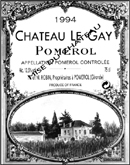
Owner: Catherine Péré-Vergé
Address: 33500 Pomerol
Telephone: 05 57 84 67 99; Telefax: 05 57 74 96 51
Visits: By appointment only
Contact: François Boyé
VINEYARDS
Surface area: 19.8 acres
Grape varietals: 50% Cabernet Franc, 50% Merlot
Average age of vines: 20 years and 5 years
Density of plantation: 5,900 vines per hectare
Average yields: 40 hectoliters per hectare
Elevage: Twenty-one day fermentation and maceration in temperature-controlled concrete vats. Aged for 18 to 20 months in barrels (60–80% new oak). Fining and filtration.
WINES PRODUCED
Château Le Gay: 24,000 bottles
No second wine is produced.
Plateau of maturity: Within 10–25 years of the vintage
GENERAL APPRECIATION
A very inconsistent estate that has a tendency to “hit or miss” with alarming frequency. At best, these are muscular, large-scaled, brawny wines of considerable power and mass. The acquisition of this estate in 2003 by Catherine Péré-Vergé and the hiring of Michel Rolland should result in dramatically increased quality.
Le Gay has been a vineyard of enormous potential, with old vines and minuscule yields of 15–20 hectoliters per hectare, but historically it has been inconsistent. Great raw materials from the vineyard are often translated into mediocre wine as a result of old and sometimes dirty barrels. Until 1982 the ancient barrels that housed the wine at Le Gay had to share space with flocks of chickens and ducks. Several years ago, a section of Le Gay vineyard (a parcel of old-vine Merlot) was sold to La Fleur-Pétrus in an effort to propel that property to a higher quality level. Not surprisingly, the vintages of Le Gay following this sale were disappointing (i.e., the 1996). However, over recent years, the estate seems to be coming back to form, but it no longer fashions marvels like the wines it produced in the 1940s and 1950s. The 1950, 1948, 1947, and 1945 Le Gays that I once tasted from magnum all remain superlative wines, with the 1950, 1947, and 1945 flirting with perfection. Shrewd Pomerol enthusiasts should search out the ancient vintages of Le Gay, as some are splendid. For example, the 1947 (rated 98 in 3/98) and the 1950 (rated 94 in 4/98) are two compelling examples of Le Gay.
The style of winemaking at Le Gay has resulted in powerful, rich, tannic, sometimes massive and impenetrable wines. In some years Le Gay can turn out to be coarse and overbearing, whereas in other vintages the power of Le Gay is in harmony and well balanced against ripe fruit, firm acidity, and tannin. Le Gay is almost always the least flattering Pomerol to taste at a young age, often needing 8–10 years of cellaring to shed its cloak of tannin. For those who prefer their Claret soft and easy to drink, Le Gay is an intimidating sort of wine. I await the result of the new administration; their first vintage will be 2003.
IMPORTANT VINTAGES
ANCIENT VINTAGES
The fabulous 1975 (92 points; last tasted 11/02) is just beginning to hit its stride after 27 years of sleep. The wine is very rich, has a dense color, and notes of liquid minerality infused with black fruits and truffle. Other top vintages such as 1966, 1962, and 1961 have been very disappointing. However, two ancient vintages that are pure perfection include the 1950 and 1947. Both wines (last tasted 12/01 from magnum) were 100-point efforts, opulent, viscous, with extraordinary sweetness of fruit and a level of concentration and freshness that was hard to believe. The corks were original, and the wines had not been moved from their Belgian cellars, where they had been kept for nearly 50 years. Obviously, this might be a wine that needs 25–30 years of cellaring before it comes into its own.
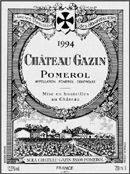
Owner: Bailliencourt dit Courcol family
Address: 33500 Pomerol
Telephone: 05 57 51 07 05; Telefax: 05 57 51 69 96
E-mail: contact@gazin.com
Website: www.gazin.com
Visits: By appointment only Monday to Friday, 9 A.M.–7 P.M.
Contact: Nicolas de Bailliencourt dit Courcol
VINEYARDS
Surface area: 59.9 acres
Grape varietals: 90% Merlot, 7% Cabernet Sauvignon, 3% Cabernet Franc
Average age of vines: 35 years
Density of plantation: 5,500–6,000 vines per hectare
Average yields: 42 hectoliters per hectare
Elevage: Eighteen to twenty-eight day fermentation and maceration in temperature-controlled concrete tanks of small capacity. Wines undergo malolactics in barrel and frequent stirring of the lees. Eighteen months aging in barrels with 50–60% new oak. Fining and filtration only if necessary.
WINES PRODUCED
Château Gazin: 25,000 bottles
L’Hospitalet de Gazin: 32,000 bottles
Plateau of maturity: Within 5–20 years of the vintage
GENERAL APPRECIATION
Gazin is a reliable growth, producing excellent wines on a regular basis. Moreover, availability is large and prices remain within limits. That being said, this estate has had a tendency to use too much new oak for the wine’s upbringing. Certain vintages do present pronounced woody aromas that I believe will never be fully meshed. This is the only reservation I have about this otherwise fruity, rich, relatively large-scaled Pomerol.
Most commentators on Bordeaux have generally held Gazin in high regard, no doubt because the vineyard is ideally situated behind Pétrus as well as adjacent to L’Evangile. In fact, Gazin sold 12.5 acres of its vineyard to Pétrus in 1969. Even then, Gazin is still one of the largest Pomerol estates, totaling nearly 60 acres. The track record for Gazin was mediocre throughout the 1960s and 1970s. Yet since the late 1980s Gazin has rebounded impressively, producing a succession of topflight wines.
Strangely enough Gazin has always been an expensive wine. A historic reputation and the strategic placement on the Pomerol plateau with excellent clay/gravel soils have served Gazin well. The optimistic signs that began in 1989 and 1988 mark a new period of higher-quality wines from Gazin and should be greeted enthusiastically by consumers wanting a tasty, plump, succulent Pomerol.
IMPORTANT VINTAGES
2001 |
Gazin’s proprietor thinks 2001 is more successful than 2000, and he might be correct. An impressive, extracted, tannic, powerful effort, this inky purple–colored Pomerol was produced from a vineyard adjacent to Pétrus. Deep and muscular, with good delineation, abundant quantities of smoky, black cherry fruit, excellent purity, and admirable definition, it will require patience. Anticipated maturity: 2008–2018. Last tasted, 1/03. |
2000 |
This is a sweet, very ripe, rich, rather dense Gazin. While the ruby/purple–colored 2000 is not a blockbuster in the mold of the 1998, nor as charming as the evolved 1999, it possesses excellent fruit, medium to full body, plenty of toasty oak, and notes of dried herbs, saddle leather, and cassis with a hint of licorice. Anticipated maturity: 2008–2020. Last tasted, 1/03. |
1999 |
An excellent sweet nose of lavish toasty oak intertwined with plums, black cherries, and currants dominates the olfactory senses. In the mouth, this wine is elegant, lush, flavorful, and savory, with medium body and no hard edges. Drink it over the next 10–12 years. Last tasted, 3/02. |
1998 |
A dense ruby/purple color is followed by aromas of charred wood, coffee, blackberry and cherry fruit, and new saddle leather. Full-bodied, dense, chewy, and intense, this muscular as well as backward vin de garde requires 2–3 years cellaring. Anticipated maturity: 2005–2020. Last tasted, 3/02. |
1997 |
A dark plum color is accompanied by an exotic nose of roasted espresso beans, sweet cherry jam, and lavish toasty oak. Soft, round, and medium bodied, with attractive fruit, this wine pushes the oak to its limit, but there is no doubting its luscious fruit and seductive, open-knit style. Drink it over the next 4–5 years. Last tasted, 3/01. |
1996 |
The 1996 is an atypically tannic, serious Gazin with a dense ruby/purple color and lavish quantities of toasty new oak in the nose intermixed with licorice, black cherries, and mocha/coffee notes. The wine displays excellent concentration, but is backward, with medium to full body and moderately high tannin. Give it another 2–3 years of cellaring as it will be potentially long-lived. It is unquestionably an impressive effort for a 1996 Pomerol. Anticipated maturity: 2005–2018. Last tasted, 3/02. |
While this deep ruby/purple–colored Pomerol hints at some of its exotic grilled herb and meat-like character, the reluctant nose primarily reveals new oak, smoke, spice, and background jammy fruit. On the palate, the wine is deep, medium to full-bodied, refined, and, except for some noticeably hard tannin in the finish, relatively seamless. This expansively flavored effort offers plenty of spice, new oak, fruit, and depth. Anticipated maturity: now–2018. Last tasted, 3/02. |
|
1994 |
This opaque ruby/purple–colored, lavishly oaked wine displays a huge, cedary, cassis, smoky, roasted meat–scented nose, unctuously textured, chewy, thick flavors, and considerable power and richness in the muscular, moderately tannic finish. This big, impressively structured Pomerol will require patience. Anticipated maturity: now–2018. Last tasted, 1/97. |
1990 |
Perhaps the best Gazin I have ever tasted, this full-bodied, opulent wine has a dark murky plum/purple color with some amber at the edge. The huge, lavishly oaked nose also shows plenty of sweet black cherries, malt chocolate, cedar, tapenade, and licorice. Very full-bodied, viscous, and rich, with a sweet entry and large-scaled, dense, and chewy mid-section and finish, this is among the most concentrated and complete Gazins of my tasting experience. Anticipated maturity: now–2016. Last tasted, 12/01. |
1989 |
Fully mature, this wine offers up notes of dried Provençal herbs intermixed with toffee, caramel, cedar, sweet black cherries, and candied licorice. The wine is medium to full-bodied, with low acidity, ripe tannin, and a soft, silky finish. It is far less voluminous and intense than the 1990, and also more evolved. Anticipated maturity: now–2010. Last tasted, 12/02. |
1988 |
Becoming increasingly herbaceous as it has aged, with notes of licorice intermixed with cedar wood, red cherries, and smoke, this medium-bodied, soft wine has been fully mature for a number of years and is not likely to improve. Its low acidity and plump, forward character have always made it an attractive wine, but owners of it will be pushing their luck to hold it any longer. Anticipated maturity: Drink up. Last tasted, 12/01. |
ANCIENT VINTAGES
Gazin had a deplorable record in the 1980s, including even the great vintage of 1982. The 1970s were even worse, as were most of the 1960s. The only top note that I have on my tasting score card is the 1961 (93 points; last tasted 12/95).
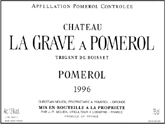
(known as La Grave-Trigant-de-Boisset prior to 1992)
Owner: Ets Jean-Pierre Moueix
Address: 33500 Pomerol
Mailing address: c/o SA Ets Jean-Pierre Moueix, 54, quai du Priourat, BP 129, 33502 Libourne Cedex
Telephone: 05 57 51 78 96; Telefax: 05 57 51 79 79
Visits: By appointment and exclusively for professionals of the wine trade dealing with the firm.
Contact: Frédéric Lospied
Surface area: 21.5 acres
Grape varietals: 85% Merlot, 15% Cabernet Franc
Average age of vines: 30 years
Density of plantation: 6,250 vines per hectare
Average yields: 42 hectoliters per hectare
Elevage: Eighteen day fermentation and maceration in temperature-controlled concrete vats. Twenty months aging in barrels with 25% new oak. Fining and filtration.
WINES PRODUCED
Château La Grave à Pomerol: 30,000 bottles
Domaine Trigant-de-Boisset (since 2000): variable
Plateau of maturity: Within 5–15 years of the vintage
GENERAL APPRECIATION
This is one of Pomerol’s most elegant, fruity and stylish wines. It is never very dense or powerful, but always seductive and impeccably made.
La Grave à Pomerol is another of the relatively obscure Pomerol estates that are now making better and better wine. Since 1971 the château has been owned by the meticulous and introspective Christian Moueix, who directs the business affairs of his firm in Libourne.
La Grave à Pomerol is located just to the east of Route Nationale 89 in the direction of France’s truffle capital, Périgueux. It is adjacent to the border of Lalande-de-Pomerol and situated on unusually gravelly, sandy soil, which results in wines that are a little lighter and less powerful than those from the Pomerol plateau. Perhaps it is because this property is owned by Christian Moueix that La Grave à Pomerol always displays a Pétrus-like personality, although it is a lighter, less concentrated and voluminous effort.
All the vintages from 1980 on have been successful, and the 1998, 1990, and 1982 are classics. Normally La Grave is a wine to drink after 5–6 years of bottle age, although in some vintages it can be cellared for 12–15 years. While not one of the most expensive Pomerols, neither is it one of the bargains of this appellation. However, given the increasing quality exhibited by this wine in recent vintages, this is a property to take more and more seriously.
IMPORTANT VINTAGES
2001 |
A refined, elegant Pomerol, this 2001 offers up aromas of spicy wood intermixed with pure black cherry fruit. Medium bodied, soft, fresh, and vibrant, it will drink well for 7–8 years. Last tasted, 1/03. |
2000 |
Atypically powerful, the concentrated, medium- to full-bodied 2000 displays more tannin and structure than usual as well as abundant concentration and sweet black cherry fruit. The dark ruby-colored 2000 should prove to be uncommonly long-lived by the standards of this estate. Anticipated maturity: 2006–2017. Last tasted, 1/03. |
Notes of sweet almonds, black cherries, and subtle herbs are found in this 1999’s moderately intense, perfumed bouquet. Medium bodied, with elegance and finesse, it will be drinkable between now and 2008. Last tasted, 3/02. |
|
1998 |
Is this a “petit Pétrus?” While it does not have the weight, power, or volume of Pétrus, the 1998 displays character similar to that of its more majestic sibling. The finest La Grave à Pomerol I have ever tasted, it boasts a deep ruby color as well as a gorgeously elegant, sweet, graceful perfume of jammy blackberries and cherries intermixed with toasty oak and mocha. Refined and sweet with a savory mid-palate, medium body, ripe fruit, and admirable succulence as well as gracefulness, its tannin is beautifully integrated, and the wine is hedonistic and complex. A sleeper of the vintage! Drink it over the next 12 years. Last tasted, 3/02. |
1997 |
A sexy, open-knit wine, this 1997 reveals toffee/caramel notes intermixed with herb-infused cherry fruit, vanilla, and toasty oak. Medium bodied, moderately intense, sweet, harmonious, jammy, and velvety-textured, this delicious offering can be consumed over the next 2–3 years. Last tasted, 3/01. |
1996 |
A well-made, smoky, coffee, and cherry-scented wine, the 1996 La Grave à Pomerol exhibits good concentration, nicely integrated acidity and tannin, and a round, attractive softness that makes it an ideal candidate for consuming in its youth. Anticipated maturity: now–2007. Last tasted, 3/98. |
1995 |
This lovely, charming 1995 reveals a deep ruby color and plenty of sweet cherry fruit intertwined with high quality, spicy new oak. Medium bodied, with excellent concentration and a nicely layered, sexy personality, this is a textbook mid-weight Pomerol for drinking over the next 5–6 years. Last tasted, 3/01. |
ANCIENT VINTAGES
As mentioned, one of the few classics in the last 15 years prior to 1995 was the 1990 (90 points; last tasted 1/01). This wine is fully mature but delicious, and it does have a somewhat Pétrus-like character, although far lighter than its bigger brother. I would opt for drinking it over the next 3–4 years. The 1989 (87 points; last tasted 4/00) is also very good, but the other surprising wine from La Grave à Pomerol that has stood the test of time is the 1982 (87 points; last tasted 11/02). This wine was fully mature 5–6 years after the vintage, but continues to hold on to life without drying out, something that great vintages have a tendency to do. Still, for anyone who owns a few bottles, it is best drunk up sooner rather than later.